Proper Sick Pay for Catering Staff Badger









• Chartwells staff in campus catering facilities including Eat Central receive inadequate sick pay, forcing ill staff to come to work.
Jude Budworth Staff Writer
The majority of catering staff in campus food facilities do not receive any sick pay for the first three days of illness, say representatives from Unite the Union. This forces staff to choose between coming to work when ill or being unable to pay their bills, causing concern not only for the employees but also increasing the risk of illness spreading on campus. The Union is launching a campaign for better and equal sick pay for all employees.
For 11 years, University of Sussex campus catering staff have worked under a “two tier” benefits system since the University outsourced catering services to Chartwells Catering in 2013. Staff previously employed by the University of Sussex received a TUPE (Transfer of Undertakings, Protection of
Employment Rights) contract, meaning that the conditions for sick pay were held over for these workers. Chartwells has since offered contracts to new employees which did not include enhanced sick pay schemes but instead included only Statutory Sick Pay, which is the legal minimum provision in the UK. Unite the Union, who recently negotiated a recognition agreement with Chartwells Catering, claim this is “blatantly unfair” as it “risks plunging people into poverty [due to] the impossible choice between taking care of their physical and mental health or being able to pay bills or buy food.”
Statutory Sick Pay (SSP) amounts to only £109.40 a week. However, according to GOV.UK, to claim the sick pay employees must meet two criteria. The first is that employees must be sick for at least four days before they are paid, after which they

are not paid for those first three days. The second is that employees must earn at least £123 a week, meaning most workers on zero-hour contracts are ineligible for SSP.
On the other hand, the few remaining TUPE’d catering staff receive sick pay that matches their wages and is paid from the first day they are off sick. This policy not only applies to TUPE’d workers and

other campus staff but also to Chartwells’ own management staff. An anonymous employee on campus said: “We are all catering assistants doing the same job [at] the same rate, therefore they should provide everyone with the same benefits. Managers get sick pay, so why not the rest of us?”
Armed police arrived on campus at around 7 p.m. on 5 March, allegedly in response to a report of an armed man making threats. The police, who appeared to be specialist firearms officers (SFOs), were seen by students entering an East Slope residence building after four police cars pulled up outside Amberley. A student was subsequently arrested. It was reported on 8 March that he has made bail. The armed police response is warranted where there is reasonable suspicion of threat to life or of weapons
possession. Witnesses at the scene report hearing that a student threatened his flatmates after an argument about Israel and Palestine escalated.
In a statement prior to the arrest, Sussex Police said: “Police were called to the University of Sussex campus in Brighton just after 6.30 p.m. this evening following a report of a man in possession of a firearm making threats to kill.” It was later reported that no firearm was found. This is the second time within a month that armed police have been seen on campus, with an
• Disparity between contracts worsens the injustice; Unite the Union demands equality for all staff on campus. p15
• Unpicking Brighton’s ‘Gay Capital’ Identity
• Top 10 Photography Spots p8

A University of Sussex spokesperson said on 6 March: “There was an incident yesterday evening and police were called to the campus. This is now a matter for the police and it would it be inappropriate to comment any further at this stage.”
Vice-Chancellor Professor Sasha Roseneil sent a message to all students on 8 March regarding “the safety and wellbeing of our community.” In the statement, she emphasised that police were onsite “within 20 minutes of a report being made to campus Security,” and thanked the security services for their work to keep students and staff safe.

• Why Do Landlords Hate Us?
• Are Sexcapades Really Needed for a Fulfilling University Life?

p25 • The Search for Extraterrestrial Life • Ice Spy: Drones in Antarctica p22

• Union Demands Proper Sick Pay for Catering Staff
• Armed Police Arrest Student
• Sussex Faces Tory MP Badenoch’s Wrath
• Eat Central to Close for Renovation
• Students’ Rent Lining the Pockets of Controversial Balfour Beatty
• Societies and SU Celebrate LGBTQ+ History Month
• UK in Recession: What Now?
• Intensifying Food Bank Crisis Signals Catastrophe for Students and Public
• Stanmer Court Recycling Goes to General Waste
• Brazilian Ambassador at Sussex
• Where It Hides and How To Find It: Joy in Brighton
• Unpicking Brighton’s ‘Gay Capital’ Identity
• Top 10: Photography Spots
• Conservation Grazing: Why There Are Sheep in Stanmer Park
• SU Advice: Moving into Privately Rented Accommodation
• Why Do Landlords Hate Us?
• Are Sexcapades Really Needed For a Fulfilling University Life?
• The Fight for Gender Equality in the Global South
• The Social Media Emergence of Neurodivergence
• Model UN Soc Takes on the (Model) World
• The Big Collab: Assange on Trial Sussex Students on WikiLeaks and Freedom of Press
• Student Spotlight: Oghenechovwe and Sustainability on Campus
• Feminism in Academic Spaces:
A Battle that’s Been ‘Won’
• Is Our University Funding Genocide?
• Tories Left Standing in Election Meltdown, in Conversation with BBC 5
• Does Anyone Else Feel Ugly?
• Brighton vs Sussex: Out of my League
BOOKS
p20
• Review and Interview: How Not to Fit In by Jess Joy and Charlotte Mia
• The Appeal of Dark Academia
• Political Agenda in the Hugo Awards
Dear Readers,
What’s up? We’re getting into egg-stremely tense territory as exams loom around the corner. For everyone also in third year, I sincerely hope you’re doing better than me in your dissertation progress. God knows I haven’t touched it, mainly them due to using The Badger as a ‘productive’ procrastination tool… and haven’t done any work since the new year. Don’t even get me started on the soul crushing, hellish experience that is applying (and receiving rejections) for graduate schemes. But enough about the crippling terror that is preparing for the future. SUPER AMAZING BADGER
This month we’ve had a lot of extra online content - from covering the SU Elections to releasing breaking news coverage of the armed police incident on 5 March! We were able to put out an article the same night thanks to friends who tipped me off quickly, and lots of Badger writers working together to investigate. I’m glad it got everyone talking!
Ada
Carpenter, Senior Editor
UPDATES!!! We’re doing pretty good, and have a ton of the eggciting content you now expect from us. By extremely popular demand, we have reinstated the puzzle page! We have a new recruit, Andrew Malarkey, who will be working exclusively on our puzzles (expect a variety of exciting puzzles to try out!). We’ve also included horoscopes on page 19! For all you Geminis with a burning hatred for Scorpio men, flick over the back page to hear how your month is going to play out.
Our next edition will be out straight after Easter break. If you don’t pick one up then prepare to get your head cracked (That one wasn’t so punny…). We will be
Working on The Badger is always a treat but I’m especially proud of everyone this edition for battling through our shortest deadline period so far. As the Senior Editor with a bias towards the arts, I’d like to highlight some exciting Arts articles, from the return of Celebrity Big Brother to the disappearance of Gleeks…
Francesca
Sylph, Senior Editor
releasing our next edition on 15 April so make sure to come see us at our usual hand out spot outside Falmer House on launch day! Lastly, The Badger team is going to Bristol! We have been nominated for 10 national student publication association (SPA) awards - which is incredible! I’m so proud of everyone for their hard work. I would list every award, but there’s not enough space to list them all (we’re struggling from success). I hope to be able to brag about our many awards in the next edition.
Happy reading (and Easter),
Semhar (Semi as in Semicircle) Tesfazgy, Editor in Chief
The Badger is back again with yet another interesting edition! From armed police on campus, to finding joy in Brighton, to onground coverage of the Assange trial, this issue is a playground of a diverse range of topics. My personal favourite, the Comment section, is back with another hardhitting Big Collab, that I can’t wait for you to read! Happy Reading!
Akanksha Pandey, Senior Editor

FILM and TV
• Celebrity Big Brother’s Big Return
• Avatar: The Last Airbender Review: An Average Live-Action Remake
• The Disappearance of the Dystopia
• Give Us Everything All At Once!
• Book Suggestions by Genre THEATRE
MUSIC
• The Culture of Record Buying
• The Dark Side(s) of K-pop
• The Mess We Seem to Make: Raw, Driven and Self Aware
• The Future of TikTok Music
• Personal Experiences at the Forefront of Performance: An Interview with Ray Young
• Gleeks: Where Have They Gone?
• SMUTS’ The Addams Family: Reviews
• What’s On in Brighton...
TUESDAY 16 APRIL
• The Search for Extraterrestrial Life
• Shattering Silicon Ceilings: Celebrating Women in Tech
• Ice Spy: Drones in Antarctica
• World Water Day 2024 Sci & Tech p28
• Will Roberto De Zirbi Leave Brighton at the End of the Season?
• Bridge The Gap Football: Brighton’s Best Student League
• Society Spotlight: Zumba
• The Brighton Half Marathon Sport p30

Jade Montana Staff Writer
The UK’s Secretary of State for Business and Trade, Kemi Badenoch, hit out at the University of Sussex recently. In an interview with The Times in February, she called out the University’s “high minded” culture among both the students and faculty, pinpointing attitudes towards Africa that inspired her Conservatism. Badenoch studied Computer Systems Engineering at the University of Sussex, gaining her Master of Engineering degree in 2003. She targeted the “snotty, middle-class north Londoners” and “stupid lefty white kids” she felt she interacted with during her time at university, who used their privilege to gain better access to education.
The Times has recently tipped Badenoch to become future Conservative Party leader, given her close loss to Liz Truss for leader in September 2022 and prominent role in government currently. In the interview, Badenoch began by answering what made her want to become a Conservative, stating that it was her experience at Sussex.
Badenoch later comments that she knew she was Conservative when “being a decent person didn’t get me the money or job position I wanted” in comparison to those around her at university. Badenoch was born in Wimbledon, London, however her family originates from Nigeria, and Badenoch has spoken widely on racism and race relations within the UK.
Badenoch went on to speak about being driven “insane… [by] how [Sussex students] talked about Africa.” It was the
“high-minded” nature among students and faculty only expressing the “need to help Africans” that resulted in her claiming that they “didn’t know what they were talking about.” Badenoch has attributed her loyalty to the Conservative Party to her experiences at university, clashing with those on the political Left throughout her career.
Badenoch targeted the “snotty, middle-class north Londoners” and “stupid lefty white kids”
Prior to Badenoch’s interview with The Times, she had a long history in Parliament of commenting on race relations and colonialism, particularly within institutions and schools. Whilst seemingly emphasising her experience of “stupid lefty white kids” during her time at Sussex, Badenoch supported a report compiled by the Commission on Race and Ethnic Disparities that declared Britain was not institutionally racist in April 2021. She clashed with Labour front benchers on the matter during a debate on the report, in which Labour accused the Commission of “cherry-picking data” and “gaslighting”.
Badenoch argued that “it is wrong to accuse those who argue for a different
approach as being racism deniers or race traitors” and stated that those who think differently should not be hit with racial slurs.
Badenoch’s parliamentary history shows that she apparently does not believe that Britain has ingrained racism, nor did she claim such in the recent interview. Indeed throughout her campaign, she has championed the stance that “our country is falsely criticised as oppressive to minorities.” Rather, her attack appears to be specific to the student and staff body at the University of Sussex, rather than a more generalised claim of racism in the UK.
Badenoch - then Kemi Adegoke - sent a poignant letter to The Badger in 2000, during her time at Sussex, that
couldn’t get more minority into one person like that if you tried.”
The letter attacked The Badger’s article topics and target audience and blamed “the more insulated parts of this campus (ENGG)” for her “jaded”, “cynical” and “right wingish” views. Her letter discussed feelings of apathy with the paper’s contents, claiming that “once you’ve read one you’ve read ‘em all.” It seems Badenoch’s recent outburst of disapproval of her time at Sussex is not the first time the University has fallen victim to Badenoch’s wrath.
There are connections between her dated letter to The Badger and her recent interview with The Times. Most significantly, Badenoch targets the student body as either “apathetic” towards Students’ Union elections or prone to doing “the exact same thing their predecessor did” if elected. Her opinion on student culture at the University clearly has not changed in the 21 years since she left.

Akshayaa Suresh and Shambhavi Shukla Staff Writers
Eat Central will close for renovations on 25 March until June. The renovations were agreed as a necessary condition of the catering contract renewal with Chartwells in 2021, the company that provides the majority of catering services on campus. While Eat Central is closed, alternatives will be provided, including additional food trucks and expanded provision of food in other locations on campus.
Post-renovation, Eat Central will be turned into a multi-use space that will also be open at night. The revamp is aimed at developing the vast café into a food court that will offer a dynamic menu curated by local vendors in addition to the classic favourites. Flexible seating arrangements and entertaining setups such as a screen and a stage are a few more improvements that Eat Central will be accommodating after the refurbishment.
The renovations will likely continue until the end of June. During this time, Eat Central will remain closed. However,
multiple alternatives within the University campus will be made available. A food truck beside Eat Central will continue serving the Sussex Saver £2 meal, along with numerous other pop-ups on the Bramber Lawns that will feature a wide range of food, from mac ‘n’ cheese, to barbecue jerk, to bao buns. Additionally, some of the usual dishes served in Eat Central will be available during this time at other University eateries, like sushi in the Botanical Cafe and Proper Cornish pasties and pies at Arts Piazza Cafe. Other restaurants on campusIDS Bar & Kitchen, The Deli, Northfield Bar, Students’ Union’s Falmer Bar, and Room 76 - will also continue their operations during this time.
However, the University has made great strides in race relations in recent years, with new and encouraging modules looking at different global perspectives rather than focusing on a eurocentric narrative. There is an upcoming project looking at the Black student and staff experience at Sussex; those involved have been reached out to for comment on Badenoch’s voiced experience.
Despite Badenoch lashing out at the University of Sussex on multiple occasions, she is recognised on the University website page on their “long and rich history with Africa,” naming Badenoch as a “young trailblazer” alumnus of ‘Sussex in Africa.’


The improvements planned for the restaurant are sure to elevate its look, ambiance, and menu from good to great.
A cornerstone of campus life, Eat Central,
A University spokesperson told The Badger: “We know from our catering consultation at the end of 2022 that our campus community wants more choice. So, we’re bringing in more counters to offer even more variety and changing the layout to reflect the way that people want to eat together, but eat different things. We are using recycled materials, introducing better ways to sort food waste, and rehoming any unused furniture to make this redevelopment as sustainable as possible.”
with its new and improved interiors and dynamically diverse menu, will blend international flavours with friendship, a sense of belonging, and the sound of a good time!
Imogen Greene Staff Writer
Despite student protests and a history of bribery, corruption and negligence, students’ money will continue going to Balfour Beatty as they construct the new West Slope accommodation. Due to lease and leaseback contracts such as the one to build East Slope, the University is effectively paying Balfour Beatty each year to slowly buy back the new accommodation, at least partially funded with student’s ever-increasing rent money. A further look into the company’s history shows behaviour which does not align with the university’s ‘five core values’ of integrity, kindness, inclusion, collaboration, and courage.
On campus, Balfour Beatty is known for disruptive construction, lights shining into bedrooms, loud drilling, and building the East and West Slope accommodations. Except for these, little else about Balfour Beatty and its history of corruption is commonly known by students.
In December 2021, Balfour Beatty pleaded guilty to one count of major fraud against the United States. As US deputy general, Lisa Monaco, explained, “they lied about the repairs [on military housing] to pocket millions of dollars in performance bonuses.” They were sentenced to pay $33.6 million in criminal fines as well as over $31.8 million in restitution to the US military, serve three years of probation, and work with an independent compliance monitor for three years.
The construction company has also faced numerous accusations of bribery. In the 1990s the Thatcher government committed aid (£238 million, equivalent to £488 million today) to Malaysia for Balfour Beatty to build the Pergau Dam.
In exchange, Malaysia would provide a major arms deal. However, it was debated whether there were other unofficial bribes involved with this agreement, specifically from Balfour Beatty. In an interview in July 2000 with The Observer, barrister Jeremy Carver said that the chairman of Balfour Beatty had announced “with enormous pride that he personally had handed over the cheque to the government minister for the Pergau Dam ‘bribe’.” In 1994 the aid for this project was declared unlawful by the UK High Court, but no bribery case was ever brought against Balfour Beatty.
However, Balfour Beatty was found in court to have bribed for contracts in 2002, when they transferred £123,310 into a Zurich bank account in exchange for a contract to construct a dam in Lesotho in Southern Africa.
Balfour Beatty’s actions are “one of the worst examples of sustained industrial negligence.”
In 2004, Balfour Beatty was fined £150,000 for breaking health and safety rules after a four year old boy was electrocuted and killed by a live rail with an improperly secured gate, despite the company being warned of this weeks earlier. In an interview with the BBC, the boy’s father said that they received £7,500 compensation, which barely covered their legal fees. Just one year later in 2005, Balfour Beatty was found to be breaching the Health and Safety Act again, after the Hatfield rail disaster in which four people died. They were fined £10 million. As stated in The Telegraph, Mr Justice Mackay described Balfour Beatty’s actions as “one of the worst examples of sustained industrial negligence.”
In March 2009, Balfour Beatty was

named by an official watchdog for unlawfully blacklisting trade union activists. They subscribed to the Consulting Association which provided secret information about workers and their political affiliations, and was later prosecuted for breaching the Data Protection Act. This opposition to their employees unionising has continued with them attempting in 2012 to challenge in the High Court Unite the Union’s vote for their employees to strike. Balfour Beatty lost the case.
Student opposition to Balfour Beatty on campus has been extensive. During the 2018 occupation of the East Slope construction site, the occupiers are quoted in The Tab Sussex demanding “Balfour Beatty… stop blacklisting trade union reps, and allow the trade union Unite unhindered and unsupervised access to the construction site”. This was met with, as occupiers explained to The Badger in 2018, a Balfour Beatty security guard telling an occupier “I will break your legs if you come over
Throughout February, Sussex celebrated the 19th year of the UK’s LGBTQ+ history month in both traditional and new ways.
Sussex-wide celebrations commenced with an online conversation with activist and author of Bisexual Men Exist, Vanheet Mehta, on 1 February. The festivities continued on 12 Feb with a panel on LGBTQA+ inclusivity in sport in the debating chamber, and ac sexuality themed pub quiz in Falmer Bar. The LGBTQ+ society screened the queer modern classic Pride in Jubilee on 22 February, commemorating British histories of gay
activism. Throughout the month, the Students’ Union also celebrated local LGBTQ+ histories on their Instagram, posting profiles of alumni from across the spectrum, including climate justice activist - and ex-SU President - Dan Glass and poet Dean Atta.
29 February, the day of Sussex Pride, saw a lot of rain and even some hail across the county. Luckily, the Sussex Pride Fair was held in the warmth of Falmer House Common Room, where a range of societies held stalls celebrating the month and our University’s wider queer culture. The common room was adorned in handmade pride decor, showcasing student creativity and passion.
The Badger held a stall, together with
Sussex’s magazine The Channel, asking students and staff “What does being queer at Sussex/Brighton mean to you?”. The fair also boasted a zine-making workshop, ‘paint your gender’ activity, and a queer bookshelf where attendees were invited to decorate blank rainbow book spines with their favourite LGBTQ+ titles. Favourites included Jeanette Winterston’s Oranges Are Not the Only Fruit and The Love and Lies of Rukhsana Ali by Sabina Khan. The atmosphere was warm and joyful, despite the adverse conditions outside.
The celebrations were rounded off with the traditional march from Falmer House across campus, during which attendees braved the wind and rain with placards, loud speakers and pride flags. Next year
the fence,” and then cutting off access to toilets and heating.
Criticism of the University for working with Balfour Beatty is still happening. Squat the Slope, who occupied Park Village accommodation in October 2022, specifically mentioned Balfour Beatty’s damage to the environment from building dams and HS2 in their open letter to the University. Their campaign demanded that “Sussex will pledge to never again sign further contracts with Balfour Beatty”.
The Lewes Court Campaign, which was formed just last academic year, successfully demanded money back on rent for students in certain accommodations close to Balfour Beatty’s extremely disruptiveand ongoing - construction work around campus.
Despite this ongoing resistance and history of corruption, the University of Sussex and Balfour Beatty continue to work together and construction of West Slope will officially begin in the coming months.

will
Abigail Keyla Staff Writer
The UK has slipped into a recession at the end of 2023, according to data from the Office for National Statistics (ONS). The ONS reported that the UK’s gross domestic product (GDP) fell 0.3% in the final three months of 2023, with a deterioration in all main sectors of the economy and a crash in retail sales. This number is higher than the predicted 0.1% drop in GDP. In 2023, the UK’s economy only grew by 0.1% overall.
This development goes against Prime Minister Rishi Sunak’s promises to boost the economy, one of the five priorities he outlined for the government when he first started his post.
But what is a recession, and how does it impact students?
A recession happens when there is a substantial, extensive, and prolonged downturn in the economy, usually happening over two quarters of the year. It is measured by the nation’s gross domestic product (GDP), which is the total value of all goods and services that a nation produces. When an economy declines, there is a drop in economic output, employment, and consumer spending, and as a result, a decline in the nation’s GDP.
A recession can be caused by several factors, from the economic, financial, psychological, or a mixture of all three. This time, Marcus Brookes, chief
investment officer of Quilter Investors, cites “persistently high inflation, structural weaknesses in the labour market and low productivity growth, but also adverse weather conditions” as the main causes of the current recession.
“
But what is a recession, and how does it impact students?
Though recessions may last for a few months, it may take years for the state of the economy to return to its former ‘peak’. The UK is still recovering from the last six-month recession during the 2020 COVID-19 pandemic, which marked a record 20.4% drop in the economy.
To sum it up, Richard Dickens, Professor of Economics at the University of Sussex Business School, says that recessions “just kind of means that the size of the pie for everyone is getting smaller.”
“So that’s bad news, because it means that we have less. We’re used to living standards, improving or economic growth, and when that slows down that’s bad news for living standards and the labour market.”
Indeed, for students, one of the biggest impacts of a recession will be the rise in unemployment, with Professor Dickens citing recessions and employment going “hand in hand.”
During this time, companies will most likely be making budget cuts and reducing staff numbers to curb overall spending. For recent graduates and school leavers,
this means that there will be less job opportunities and lower starting salaries. This is also true for students looking to find part-time work, presenting a difficult situation especially when students are “more likely to work nowadays than they did ten years ago to supplement their education.” For those already employed, it may be harder to get promoted or get wages that can keep up with rising prices in the current cost of living crisis. This trend is likely to continue even as the economy recovers.
Research from Stanford University’s Institute for Economic Policy Research (SIEPR) has also discovered that graduates who start working during a recession make less money, though they work more compared to those who start work during periods of economic growth. For “recession graduates”, SIEPR finds that this “bad luck” can be detrimental, leading to “permanent differences in life circumstances” and even a higher death rate when reaching middle age, likely due to unhealthy lifestyle behaviors.
While they do paint a bleak picture, recessions are a necessary part of the economic cycle. The economy will inevitably rise and fall, and so recessions can be quite common, though they aren’t as frequent or prolonged as before, according to Investopedia.
“Perhaps sometimes recessions do this kind of thing as well, that where they speed up a company’s decisions, they may
clear out sectors of the economy that are perhaps not performing well, and that kind of can perhaps open the gateway for new sectors to emerge, I suppose. But it’s often a painful process for everyone involved,” Professor Dickens says.
“
For students, one of the biggest impacts of a recession will be the rise in unemployment.
He claims that this recession “feels a little bit different,” in particular with how there are labour shortages in particular sectors, which have led to more firms hiring. This is compounded with the “quite big increases: in the national living wage since 2016, where “workers at the bottom have seen the biggest increases” – a stark contrast to previous decades.
“So it’s not all doom and gloom,” Professor Dickens ends.
As always, what goes down needs to come back up again. Reuters claims that this recession is likely to be ‘short-lived and shallow by historical standards’, with politicians and experts are already claiming that the economy will pick up by the end of 2024. While there is not much the individual student and recent graduate can do to mitigate the effects of a recession, such developments may give hope for better conditions in the future.
Amina Daniel Staff Writer
The usage of food banks in Brighton and Hove has surged by 25% over the course of a year, as the Emergency Food Network (EFN) reports that numbers reached over 6,400 people per week by the end of 2023. Food banks have been struggling to meet demand for years, and as the UK dips further into economic recession while the cost of living continues to rise, the situation is diving headfirst into catastrophe.
The EFN’s 2023 report paints a bleak picture, revealing an escalating number of individuals across diverse demographics unable to afford basic necessities. The Badger spoke with Ali Ghanimi, Senior Manager of the Brighton & Hove Food Partnership, who shared insights on the persistent rise in food bank reliance since the introduction of austerity programs by the coalition government of 2010. These measures included cutting benefits to the point that recipients are unable to come close to covering basic essentials. Ghanimi also highlighted the distressingly high number of people on fixed incomes compelled to resort to food banks; stagnating wages paired with rapidly

increasing costs of living have pushed many into desperate situations, and with bills to pay, food is the only option to cut out.
Among those turning to food banks have been a significant number of students. Many struggle with inordinately high Brighton rent, unable to cover bills with maintenance loans that have not kept pace with rising costs. International students, burdened by steep tuition
fees, further contribute to the already overwhelming numbers seeking assistance from food banks. The Badger spoke with the ex-managing director of a food poverty charity, who commented on the emotional toll of working at a food bank, revealing the constant struggle to avoid turning away those in need. This is fast becoming a tragic reality, as some food banks are already having to pause new referrals.
Adding to the urgency is the impending expiration of the Household Support Fund (HSF) on 31 March. This emergency fund is crucial for those facing unexpected financial hardships without savings to carry them through. It also serves as vital governmental funding for local food banks, and in many cases is the only thing keeping them afloat. Despite campaigns for its extension, Ali Ghanimi warns that the government shows no signs of answering these calls. “If they don’t continue the Household Support Fund,” said Ghanimi, “it is going to be a catastrophe.”
The core issue lies in the ‘cost of living crisis’, a phrase normalised to the point that it now carries an air of apolitical unavoidability. However, delving into the context encourages examination of the government’s reluctance to increase wages in proportion with rampant inflation. This
stance facilitates a wealth transfer from the hands of ordinary individuals, to huge corporations who dominate essential supplies like food and fuel. Corporate giants like British Petroleum reap the benefits of inflation, while the public, left with no alternative, bear the financial burden. Without addressing the root cause of this continuous financial drain through proper systemic change, these ‘crises’ will continue to persist.
Until substantive systemic changes are enacted, efforts to mitigate the impact of poverty and inequality remain imperative.
For students in need, the University of Sussex provides subsidised £2 meals in Eat Central, and is also currently running a ‘pay it forward’ scheme, where people can pay for someone else’s food or drink. Donating to local food projects whenever possible is also hugely helpful; visit the Just Giving webpage to contribute to crowdfunders launched by multiple Brighton food charities. Emailing local MPs about the urgency of continuing the HSF fund is a start, and as the general election fast approaches, it is imperative to pay close attention to the governmental decisions that determine nothing less than the quality of life for us all.
The Branch Secretary of Unite the Union, Daniel Hyndman, told The Badger that the Union has “really good […] early days relationships with local managers [of Chartwells]” and that the Union will soon engage in “proper initial negotiation meeting[s] with Chartwells management” to improve catering assistant contracts. Hyndman believes that the fact this dispute is occurring on a university campus lends the Union significant leverage. “[We are in] a progressive, enlightened, higher education institution” Hyndman says, arguing that student and university support can supply much needed pressure towards Chartwells.
It is “hard for Chartwells to plead poverty” on this issue.
Chartwells is the nationwide education catering branch of the larger international firm Compass Catering, which boasted profits of £1.89bn in 2023. Unite hopes that Chartwells will agree to the demands and be held financially responsible for providing sick pay in line

with other university staff. Hyndman believes it is “hard for Chartwells to plead poverty” on this issue, but fears that they may ask the University to bear the burden of providing enhanced sick pay.
Without sick pay, illness is more likely to spread, putting vulnerable people at risk!
This issue affects not just the workers, but everyone who eats in Chartwellsoperated facilities. This includes Eat Central, the Arts Piazza, Botanical Cafe, ACCA, and most other eateries on campus. By making it difficult for staff to stay home when sick, Chartwells increases the risk of spreading illness to staff and students.
One employee told The Badger: “Those who have vulnerable family members, or are vulnerable themselves, would like to feel reassured that illness will not be spread at work. Without sick pay, illness is more likely to spread, putting lots of people at risk! If you’ve got no choice but to come in when you’re ill, it’ll have a knock on effect on everyone, Chartwells

staff or not!”
Hyndman emphasised the University of Sussex’s “massive stake” in this dispute. The University’s 2025 Strategic Framework lays out a commitment to five core values, including “kindness” meaning all those on campus “care for each other”, “integrity” meaning the treatment of all staff and students with “dignity, respect and courtesy” as well as the “courage […] [to] speak out on issues that concern us.”
Conditions are unsafe, unhealthy and unfair to both customers and workers.
Unite the Union presented a statement to the Equality and Diversity Inclusion
Committee last month, emphasising that the existing contracts lead to conditions that are “unsafe, unhealthy and unfair to both customers and workers.” Unite are in the early stages of negotiations with Chartwells.
Commenting on the topic, a Sussex spokesperson told The Badger “Following the signing in January of the formal union recognition agreement between our campus catering partner, Chartwells, and the Unite and UNISON trades unions, plans are now underway for the election of representatives. We understand that once these elections are complete, then Chartwells and their trades unions can discuss this important matter.”
Jack Timmins Staff Writer
For nearly six months, a sign outside both of the rubbish disposal areas for Stanmer Court accommodation states that “recycling is currently going into general waste because it’s contaminated.”

If there’s an issue or event on campus that you think The Badger should cover, send us an email or message with the info!


The University of Sussex aims to become one of the most sustainable universities in the world, with the Sustainability Strategy, published June 2021, setting a target of 50% of its waste to be recycled by 2025. The apparent ongoing issue with contamination undermines the credibility of that goal.
The apparent ongoing issue with contamination undermines the credibility of Sussex’s sustainability goals
Stammer Court is the only accommodation off site. It is easy to access on foot, right next to Falmer Station, but in order to access by vehicle you have to drive through the Southern Water site off the A270. This degree of separation from the Falmer campus, alongside the inconvenience factor, may contribute to a certain reluctance to properly address the recycling problem.
In email correspondence with the Sussex Estate and Facilities (SEF) flagging this issue, they stressed the requirement of recycling. In one email to The Badger, SEF replied with reference to the accommodation handbook which highlights the issue of contaminated recycling. On page 16 of the handbook it
states: “All students are required to place recycling into the external bins provided. If non-recyclable items are mixed in recycling bins, the contents become contaminated, and all of the waste will have to be processed as general waste.”
If recycling is a requirement, its proper disposal should be too. There has been no information from SEF about what is being done to address the issue, nor any updates to Stanmer Court residents since the signs were put up. It is unclear whether recycling continues to go to general waste or if the sign is outdated.
Furthermore, it appears that Stanmer Court is the only accommodation with this sign. Nicola Thomas, the residential building manager for Stanmer Court, stated: “This does happen in all areas on campus – including other residences – but Stanmer may be the only area that has this signage.” When questioned on what
is being done to address this, she went on to write: “Regrettably, this is a continued issue with recyclables ending up in the general waste stream.” If this is the case and indeed is regrettable, then why has it gone unresolved for at least half a year?
Why has it gone unresolved for at least half a year?
Considering the innovative measures Sussex is taking to combat waste and reach its sustainability goal, with a recent example being a pilot initiative led by Dr Andre M Chagas to turn Sussex’s plastic waste into 3D printing filament, clearly this is an issue which strikes at the heart of what the University and its students stand for - working for a better tomorrow. This is only possible if it is a joint effort and a collaboration between students, the administration, and SEF.

Brazil is back” was the slogan used by Luiz Ignácio Lula da Silva (Lula) when he was reelected President of Brazil in 2022.
The Brazilian Government’s recently appointed ambassador to the UK, His Excellency Antônio Patriota, was on Falmer campus on the evening of 15 February, paying a visit to the Institute of Development Studies (IDS). As part of this visit, Patriota gave a lecture on the priorities of Brazil’s government, towards tackling pressing global challenges. The event was a part of IDS’s “Brazil in the World” event series. The talk was chaired by Peter Taylor, the Director of Research at IDS.
Brazil, which is set to be the host nation of COP30 in 2025, is the world’s eighth largest economy and boasts the sixth largest population. Brazil is, importantly, the home of the Cerrado ecoregion and vast swathes of the Amazon rainforest, the largest rainforest on the planet, making it an indispensable player in global climate decision making.
Antônio Patriota, who has previously served as Brazil’s ambassador to the United States, Egypt, and the United Nations, highlighted the importance of his visit to Sussex. Patriota stated that IDS “speaks the same language as the government I represent”, emphasising the shared values of sustainability, democracy, and the rule of law. The talk focused on the value of sustainable policy, highlighting Brazil as a country at the forefront of climate and environmental debates, with both its vast ecosystems and Lula’s current incumbency as chairman of G20. Patriota emphasised Brazil’s status as having the cleanest energy matrix within the G20 which, according to Ember, puts the country’s share of electricity output as being 89.1% clean. Patriota highlighted that 45% of this is from sustainable sources of energy, putting Brazil at the forefront


of climate action. However, no matter the actions Brazil takes, “the Amazon will still be under threat due to global greenhouse gas emissions.”
Patriota went on to list the three core priorities that shape Brazil’s approach to COP30.
These included the goal of tackling hunger and inequality, which Patriota referred to as the “enemy of sustainable development” and of democracy. This goal focuses on rural, especially female, workers, who are the most vulnerable to inequality and its effects, with inequality being one of the many subjects which IDS studies. The second major priority Patriota

outlined was combatting global warming, and in doing so, taking responsibility not just for existing populations but for future generations. The final priority of the Brazilian government was improvement in international governance. Lula’s stance is that the current system, specifically the United Nations, is working inadequately and must be improved in order to better tackle global challenges. One solution Patriota put forward is an overhaul of the UN Security Council (UNSC), in order to make it more representative. The UNSC has often been criticised for being outdated, giving too much power and influence towards countries which were large international players at the time it was founded after the second world war.
Patriota went on to bring the focus on climate action back closer to home. He praised IDS as a focal point for think tanks in Great Britain whilst also emphasising the UK’s potential to play a huge role in global cooperation. Despite the UK government reducing the percentage of GDP spent on cooperative action, Patriota claims to have picked up a strong sense of “desire for cooperation” within the UK, with Brazil being “more than predisposed” to working with the UK once again.
With a Labour victory seemingly on the horizon for the 2024 General Election, it will be interesting to see how the UK’s stance on cooperation might change.




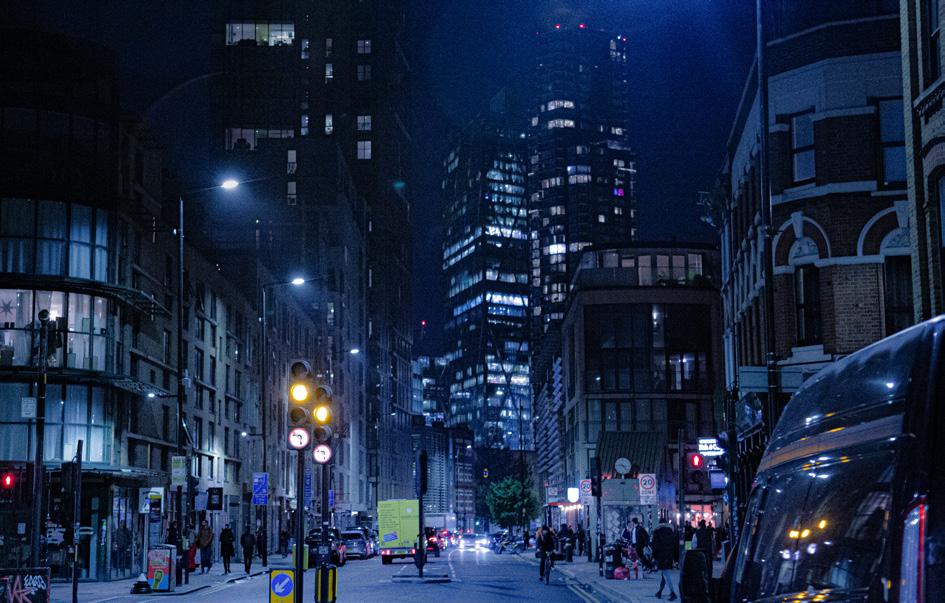











Manasi Barmecha Staff Writer
Joy is not meant to be a crumb
- Mary Oliver
At the Brighton station, right before you tap in, there is a piece of rather unexpected furniture. Despite being painted in colourful stripes, it is invisible until you look for it. Next time you go, watch out for this piano. It sits peacefully in the centre of Brighton station, unfazed by our hurry. If you go before 7 p.m., you can even play some tunes once you ask the guards to open it for you.
If you are facing the pier, on its right at the beachfront are several tiny shops tucked away in the historic Kings Road Arches. One of them is a gallery named Daniel Laurence, a Brighton-based artist whose work, in his words, “pays tribute to God’s glorious creation.”
As you enter the quaint little gallery, it transports you to a quirky, expansive space. Where divers’ helmets are ornamental, the crockery is Beauty and the Beast-styled, and wooden ducks wear trendy shoes. The
gallery is filled with wonder but there is one thing at the very back that makes me squeal with delight (an essential ingredient for joy): a little tropical reef fish tank housing exactly two fish. Nemo and Dory.
Go see them, your own little real life adaptation of the movies!
Along the Hove seafront is a newly installed artwork “Flight of the Langoustine” by Pierre Diamantopoulo. This impossibleto-miss sculpture has been described by Pierre as “an absurdist response to a profound sense of unrest”. I saw this sculpture on a lazy Sunday afternoon as I walked leisurely with a mint choco chip gelato from Marrocco’s in my hand. I will refrain from telling you what the sculpture looks like, but to me, it seemed unafraid, bold, and - like all of us - trying. I thought to myself, “It is okay to be seen trying,” and in that solace was my joy.
The Laines are a popular source of joy and I am convinced that one can spend a lifetime locating all the joy to be found here.
There is a shop called ‘The Duck House’ which true to its name, houses only ducks. Shrek duck, The Queen duck, Fireman
duck. Everything except the shopkeeper here is a duck and I ducking love that!
On the walls of the Middle Street Primary School in the Laines is a beautiful artwork of Lord Ganesha, the Indian God of sacred beginnings. There is something immensely joyful about finding a popular symbol of faith from your own country graffitied onto the walls of a country far far away. He is my favourite God because he just knows how to have a good time.
The best hot chocolate I have ever had: Knoops! Nothing screams joy like a steamy drink with the percent of chocolate you desire and a dollop of whipped cream as you fancy.
Right opposite Burger King on North Street, there is a brightly coloured mural by Dave Pop that reads YOU LOVE YOU on first glance. If you squint your eyes a little and read between the lines (literally), it says something quite different. Reading it made me smile and something in my heart felt warm and fuzzy. Maybe it was the mural, maybe it was something else. I have learnt not to question its origin when joy visits me. I hope joy finds you soon, squinting outside Burger King.

I wish you Joy, in these places and many more I ask you, most earnestly, “What brings you joy?” Tell me, because I want to know.
To many, Brighton is known as the ‘gay capital’ of the UK. The city’s vibrant reputation has made it a popular safe space for members of the LGBTQ+ community, dating back to the 1930s, in which it flourished as a holiday destination for lesbian and gay couples. Since then, Brighton has hosted countless pride month celebrations formed a friendly environment where people can express themselves freely. A recent study by University Compare found that 10.7% of Brighton’s population identifies as lesbian, gay, or bisexual, with a large number of this community being made up of university students. Since the early 2000s, the significant of young education, jumping to Brighton seems to be full of us. Alongside this increase

comes a growth in Brighton’s nightlife scene, evidently shown as the city secures itself as 2nd in the ranking of ‘friendliest city for students’, with the highest nightlife score of 4.5/5. Included in this data are various lesbian and gay clubbing bars, such as the popular Revenge Nightclub, which is known for fostering inclusivity and prides itself as being the biggest and best LGBTQ+ venue in Brighton. However, even with a plethora of safe spaces being offered to members of this community, University Compare’s study did not award the same praise for the overall safety of the city, ranking it as 26th in a list of 50. Competing against London’s LGBTQ+ safety score of 100%, we must ask ourselves why Brighton has fallen so low, considering its strong historical and cultural connections to the community.
The findings of the study call into question the stereotype that Brighton is one of the most accepting cities in the UK. University Compare is not the only project to dispute the general safety of the city. Corroborating the research is a two
year study conducted by a collaboration between the University of Brighton and the mental health charity, MindOut, who have analysed the struggles faced by queer individuals who have recently moved here.
A recent study by University Compare found that 10.7% of Brighton’s population identifies as lesbian, gay , or bisexual
In their project, researchers found that many LGBTQ+ people had sought guidance from MindOut in regards to their declining mental health, social isolation, and shifted sense of belonging. Having moved to Brighton with the expectations that they would experience the ‘safe space’ that has enhanced the city’s reputation amongst the community, many participants felt they had been ‘cheated’ and thus were greeted with disappointment. Furthermore, several participants had felt unsafe and discriminated against due to their sexual orientation, leaving us to speculate how safe Brighton really is for minorities.
Although such research has helped to shed light on safety issues surrounding this community in Brighton, many students at the University of Sussex feel differently about their experiences as young, queer people. Responses submitted to The Badger answering the question ‘What does being queer at Sussex mean to you?’ largely contradicted the negative findings of these research reports. Students reported feeling more comfortable displaying their sexuality in public, knowing they will not be judged or harassed for doing so. Others expressed the strong sense of community surrounding Brighton and the acceptance that comes with it, making us wonder if these experiences are determined by other factors such as age and occupation. While the city has long been celebrated for its energetic and inclusive spaces, University Compare somewhat reveals a dichotomy in experiences. Despite the city’s high ranking in terms of its nightlife and LGBTQ+ venues, concerns about safety persist, indicating a need for better safeguarding of this community. As individual accounts from Sussex students present a contrasting view, it becomes evident that open mindedness amongst the newer generation plays a significant role in shaping the experience of young, queer people in Brighton. The complexity of Brighton’s identity as a ‘gay capital’ calls for a more nuanced discussion that goes beyond generalised assumptions and instead explores the varied experiences of its residents.
Will Gaffney Head of Photography
Here are some of the best places to take pictures in Brighton, whether you want to capture a cute Instagram story or a more professional photograph. This list highlights stunning landscapes, the beauty of nature, a simple selfie, as well as the enchaning feeling of sonder of Brighton’s streets.
Hollingbury Park sits high up along Ditchling Road, offering an amazing view of Brighton’s centre and the sea, perfect for a landscape picture. Sunset is a great time to visit; as you can see, I got lucky and had a pink sky.

10
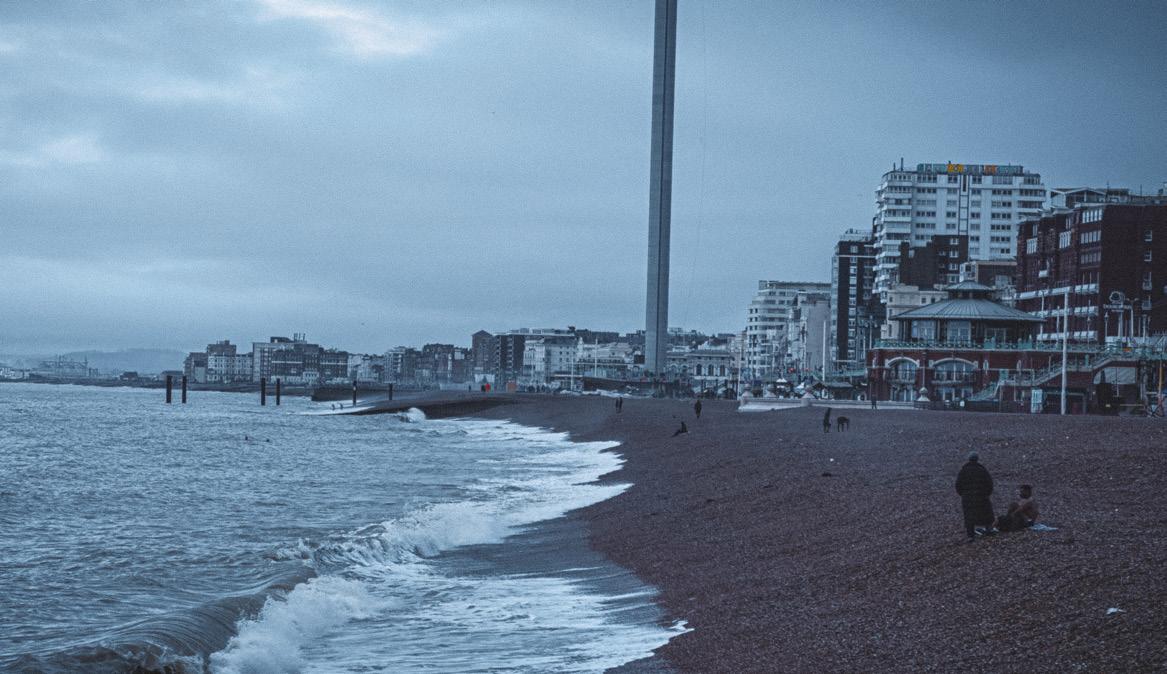
8
The pier is always busy, so you’ll be able to capture the bustling atmosphere of its amusements. Alternatively, there are plenty of themed cutout boards to take some cheesy pictures.
With the boats and sea surrounding you it’s impossible to get a bad picture. As the sun sets, it paints the boats and buildings in golden light. With the clouds looking like breaking waves and the breaking waves looking like... breaking waves, the Marina will create a new latibule for anyone who goes.

The weather isn’t always perfect in Brighton, and that can make your photos look gloomy and sad; although, that isn’t always a bad thing. The beach is very adaptable since you can shoot the sea, the sky, friends, and activities.


6 7
Kemp Street’s Pink House
On Kemp Street, there are a cluster of colourful houses. Of course, the cotton candy coated, Barbie dream house will be a great pink hello kitty girly-pop Instagram post! #Thisisgirlhood
Devil’s Dyke is a dream for photographers. The waves of greenery surround you for miles, while paragliders dive into the frame adding a dynamic feel to the scenery. It is best to come midday so you can see as far as your eyes will let you.

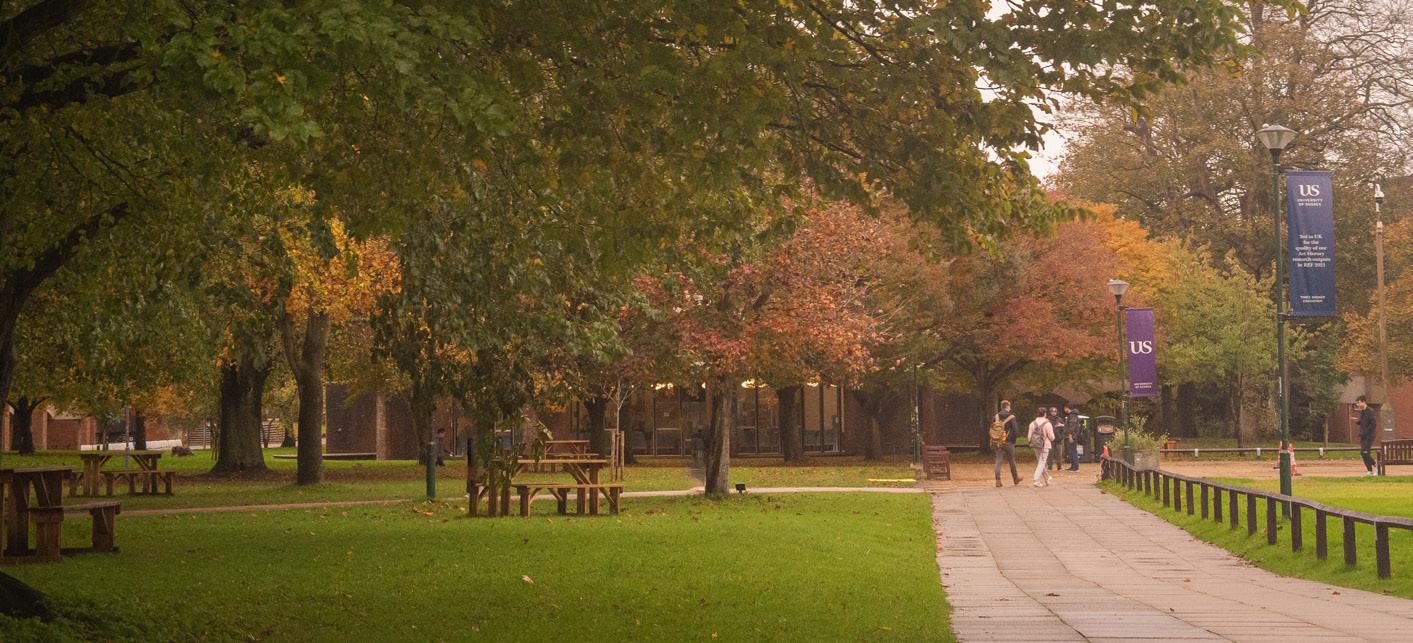

The best time to capture The Laines is over the Christmas period, as the charming lights provide such atmosphere to your photos. Not having to rely on the sun and the weather helps too.
4 2 1
The nature around campus is always beautiful, but can be neglected since it is commonly seen. It’s especially beautiful in the spring, with all the blossoming trees ensuring a picture-perfect location.
3
The white cliffs towering majestically are the art piece with the camera as a brush. With one shot, you can easily capture the dramatic beauty of these iconic chalk cliffs. You will need a coat!

Finally, a photo of you and your friends having fun together will be treasured more than a picture of a hill or building. Whether it was taking my camera to a friend’s house, a pub, or even a club (never again), documenting the night for everyone who will forget, which will be almost everyone. It can also be great to show our kids in the future, making them either create a “my mom/dad in the 90s” edit for the new TikTok, or asking us what the f*** happened.

Editor: Anna
Adri Whittingham Staff Writer
If you’re lucky enough to snag a window-side seat on the buses to the University, you might have noticed

the woolly guests residing in our beloved Stanmer Park. For the last month, sheep have inhabited the hillside by the Park’s entrance, providing a new sight for the dog walkers, playground users, and the adjacent coffee stand. Many Sussex students know the neighbouring park well - along with the longstanding roaming cows whose moos echo to Northfield and West Slope. The appearance of sheep has turned heads and created a wave of curious students. When did they first appear? Why are they here? And what do they want from our dearest Stanmer Park?
Chalk grassland across the national park has been ploughed and destroyed due to human intervention.
The presence of sheep in the park is actually a yearly tradition, residing in the park throughout the winter, grazing on the grass during the Christmas break. This year however, they arrived slightly later. Setting foot in Stanmer on 24 January, the sheep were moved by lorry from Whitehawk Hill, where they had grazed throughout Summer and Autumn. The sheep stayed for a six week period, until 6 March, according
to the @BHSheep X page. This constant operation of moving sheep and grazing the grounds in parks around Brighton is part of the South Downs National Park’s conservation grazing efforts, an initiative that takes place throughout the South Downs.
So what exactly is conservation grazing?
The South Downs National Park, which includes Stanmer Park, is the most populous national park in the UK and is home to an extremely biodiverse landscape of flora and fauna. Conservation grazing is the act of using animals to mow the protected grasslands to prevent the destruction of insect life. It also removes plants and invasive weeds while keeping the soil fertile with their excrements, naturally ensuring the health of the grass and its microbiomes.
Over the years, the chalk grassland across the national park has been ploughed and destroyed due to human intervention. The chalk grassland that remains can contain up to 40 subspecies of plant and insect life such as the Round-headed rampion and the Adonis blue butterfly that needs to be preserved. The South Downs National Park implements the use of conservation grazing across the southern coast along with other conservation
Florrie Petit Staff Writer
Moving into privately-rented accommodation can be daunting, especially if it’s your first time. The Students’ Union advice team provides advice on University-related issues and housing for every Sussex student. If you have a question about an area they don’t cover, they can point you in the right direction to get help. Here are their top tips to keep in mind throughout the renting process.
Contracts:
• Read your contract and get it checked over by the Student Union Advice Team before signing it.
• Tenancy contracts are legally binding for their full period unless there is a ‘break clause’ allowing for early termination. This means that you are liable to pay the rent until the end of the contract, so be sure before you sign.
• Most tenancies in shared accommodation will be ‘joint tenancies’. This means that if one of your housemates fails to contribute their ‘share’ of the rent, the landlord can demand it from the remaining tenants or their guarantors to cover any rent shortfall.
• The landlord or agents need to give you 24 hours’ notice if they want to enter your accommodation, unless there is an emergency – for example, an urgent repair issue.
• The landlord will have a legal obligation to ensure that the property is safe, that you have essential services (water, electricity, etc.), and that the basic structure of the building is in good repair. Report any safety concerns in writing to your landlord or agents.
The landlord will have a legal obligation to ensure that the property is safe.
• Beware of any fees your landlord may try to charge you – The Tenant Fees Act 2019 imposes strict rules about the type and extent of tenancy fees.
• If you rent a room in a landlord’s home then your rights will likely be less than tenants with a non-resident landlord.
• After you pay your main deposit, check that your landlord or letting agent has registered it with a Governmentapproved tenancy deposit scheme
initiatives, such as its ReNature programme that addresses land management in the context of climate change.
The sheep coming to Stanmer is a yearly fluffy occasion many look forward to. They have grazed on the downs for centuries and it’s only right to keep them doing so. The care and maintenance of the sheep are supported by volunteers called ‘lookerers’, who check on the grazed downlands and make daily reports. Visitors to the park also look forward to the fleeced guests.
The care and maintenance of the sheep are supported by volunteers called ‘lookerers’.
Nicky, an employee at Circa in the Park said, “We love to have them here. It brightens up the scenery… everybody loves that they’re here.”
The sheep in Stanmer Park definitely made their stay known and will be a treat to see when they come back around next winter. You can keep up with the sheep by trying out lookerer-ing via the Brighton & Hove City Council website or through the @BHSheep X page that provides updates on the sheep’s whereabouts!

within 30 working days to protect your money. The schemes have an adjudication service which may help you if you believe the landlord is asking for an unreasonable deduction from the deposit at the end of your occupation.
• As a full-time student you will be exempt from council tax, but you still need to complete relevant online forms. If you live in the BN1, BN2, BN3 or BN41 postcodes you can claim for council tax exemption on the Brighton & Hove City Council website.
• Before you move your things in, take time stamped photos of any pre-existing damage or defects around the property, ensuring the written ‘inventory’ is accurate.
• Bills – make sure to take readings of all the relevant metres (gas, electric) and send them to the utility company as soon as possible.
Visit the SU support page for more information on university-related issues or to book an appointment with the Students’ Union advice team. Appointments are available in-person, via video call or by phone.






Bec Nicol Features Editor
You’re a student and chances are you’re living in a slightly mouldy semi detached house somewhere in Brighton or its surrounding areas, and suddenly the bathroom light won’t stop flickering or the fridge feels a little er, not cold. Naturally you pick up the phone to contact your landlord or rental agency. Your landlord who may I add is probably making well over five-hundred quid a month off you living in their hand-medown room, and times that by 3 or 4 or 5 depending on how many housemates you have. Anywho, alas, they don’t answer or they say they’ll send ‘someone’ round to ‘look at it’ at some point in the near future. Better yet you contact your rental agency and they say they’ll ‘let the landlord know’ and then you have to wait for whatever comes of that.
Maybe it’s just me but does it ever feel as though you’re bothering them? The people we pay to give us a service and whenever we need it they make you feel as though you’ve contacted them the day of their mothers funeral asking where the hoover is.
There is an indefinite air of blasé bluntness to the way landlords treat their student tenants.
There is an indefinite air of blasé bluntness to the way landlords treat their student tenants and same goes for the rental agencies we deal with. I’ve experienced it myself and seen many fellow students endure housing related horror stories through no fault of their own. This article will recount some of the more glamorously appalling but all too common stories that have occurred in Brighton.
Firstly, we have Charlotte, who at the time had just finished her second year of Uni at Sussex and was nearing the end of her second year tenancy. Throughout her tenancy (which cost £650 a month, something her student loan barely covered) her and her 3 housemates had issues with the bathroom.
“It was getting black mould very, very easily. The drains were blocking really easily and there was a weird smell coming from the drains. It made it very difficult to clean because then the water wasn’t draining properly after our showers… we’d made our landlord aware several times”.
So, Charlotte’s landlady decided that it was indeed time to give the bathroom a bit of TLC. She organised for builders to come and replace the house’s bath with a brand new shower, and booked the project to begin just 3 weeks before Charlotte’s tenancy was due to finish. There were several issues with this including that not only does it demonstrate the landlords disregard of tenants issues with the bathroom throughout the larger portion of their time there, it also left Charlotte without a bathroom.
She explains that while two of her housemates had gone to stay at their family homes for the summer, she and another housemate stayed in Brighton working. The two tenants living back home preemptively agreed to the work in the house being done. Meanwhile, Charlotte and the other person who both worked night shifts at the time in the hospitality sector spent many sleepless mornings listening to the builders chip away.
There’s nothing like waking up slightly sweaty in the hot summer after a night surrounded by spilling pints and plates of various foods to the sound of builders, and oh did I mention they had no place to shower?
As a ‘solution’ to this problem bestowed upon contractual paying tenants the
landlady gave the two students (in Charlotte’s words) “keys to her other property that wasn’t currently occupied… [so we had to] walk 20 mins to another house every time we wanted a shower which was horrific because then by the time we had showered and walked back to our house we were already sweaty and warm again”.
When asked what her rental agency Coapt, did to help this situation Charlotte replied “they said it was a problem with the landlady not them.”
Next, we have James, who last year around this time met a nice group of boys off Facebook to rent a house with.
He’s still unsure if what happened was even legal as all the documents required to rent a house had been signed.
In his words they all “went to a few viewings together before settling for a really nice house. We paid for the deposit and signed all of the tenancy agreements in around April time, set to move in on September 7th.”
Suddenly though, around July, he receives a call “out of nowhere” from the rental agency, Harringtons (who they had secured the house through). The landlord had pulled out. The group’s plans were shot and they had about 7 weeks to find a place to live before the new Uni year began. James says he’s still unsure if what happened was even legal as all the documents required to rent a house had been signed.
It was impossible for the group of lads to find a place together in such a short space of time, so James ended up renting a room in a house that was advertised to him as being “a mix of students and working professionals.” Instead, he describes the place as dodgy and chalks up the whole thing to be a traumatic experience as he
had to deal with 30 something year old people stealing his food and bringing bed bugs into the house.
Numerous other stories were shared with me during my research for this article, the most common was to do with landlords ignoring calls to rectify large patches of mould in students’ bedrooms that are causing many of them health problems.
How all these unsettling and potentially dangerous events continually and not uncommonly happen to students is what is most concerning. Personally, I believe a large part of it is to do with the perceived vulnerability of student renters. The median age of landlords in the UK is 58, as well as this 48% of landlords are unwilling to let to students. We are a demographic who lack options in the rental market, and are looked down upon by landlords and rental agencies who use our lack of experience in this area to pull fast ones on us. That can range from having minimum effects on our lives all the way to outrageous ones.

Ciaran Barry Staff Writer
Sex is a topic that has always got tongues wagging, whether around campfires, in club smoking areas, or behind closed doors. The intrinsic intimacy of knowing that in that moment someone craves you entirely for what you are and nothing more has always sparked conversation. However, as students, one fact we can all agree upon is the prominence of casual sex and hookup culture surrounding university life and the many benefits and problems that come with it. Opinion on hookup culture is entirely non-polar, it is
almost as complicated as sex itself, and one doesn’t need to be for or against it. Instead it can be seen as completely dependent on environment and varying factors, or in less scientific and nerdy terms, whether the vibes are simply there.
Campus is a terrarium brimming with hormonal teenagers who up until fairly recently have probably not been able to properly explore.
Campus is a terrarium brimming with hormonal teenagers who up until fairly
recently have probably not been able to properly explore sexuality liberally and without someone’s parent knocking on their door, hence when they are unleashed at university is it any wonder that they want to try everything they should want?
And perhaps that is where one of the first positives of hookup culture in university comes from: the opportunity to, should you wish to, experiment and push boundaries. It’s an exciting time to find what you do and do not enjoy, obviously whilst regarding respect and consent. Navigating all the urges and impulses one has is difficult at the best of times, however one might, for example, sleep with a person or two
and realise they wish to engage in a monogamous yet sexually adventurous relationship. Whereas another might decide they wish to have several partners at once, all of this being viable due to sexual choice and the exploration that comes from hookup culture. Honestly, the amount one learns from experimenting with sex can be truly mind blowing, for example that men are better at using their hands during sex than they are at using their hands to send you decent replies! Of course, as with every positive sexual experience, there is bound to be a negative, and I figure the word count I have been given will not do justice to what
Abigail Keyla Staff Writer
When thinking of the fight for gender equality, large Western feminist movements such as Me Too and Time’s Up come to mind, and for good reasons – they were powerful, prominent, and widespread movements that caught the worlds attention and raised global awareness on the multitude of injustices women face
But have you wondered, what a local, grassroot’s fight for gender equality in the villages of the Global South looks like?
Minha is a 20-year-old university student born into a rural village in Lombok, West Nusa Tunggara in Indonesia. She is a passionate advocate and spokesperson on children’s and women’s rights in her village, and has been ever since she was in high school.
I had the pleasure of meeting Minha through the non-profit organisation, Save the Children Indonesia, and was in awe of how much she has already accomplished at such a young age. When I asked her what first inspired her passion in gender equality, Minha tells me that it started when she reflected on the patriarchal culture and systems entrenched in her village.
In her region in particular, males are regarded as more superior to females, and this is demonstrated with how women have to wait for the men of the house to stand, wash their hands, or eat before they are allowed to do the same. She talks about the ancient caste system, where a woman with blue-blood (descendants of royalty) has to marry a man of equal status, otherwise she could possibly end up disowned by her family. Unsurprisingly, the same rules do not apply to men. Such a system was still around when Minha was born, but is not as prominent now as it was then.
In her village, being a woman also meant that education was not a priority,
due to the stereotype that women would inevitably be in charge of the household and the children. Instead of continuing into higher education, girls are placed in home economics classes to prepare them for marriage and taking care of their family. Boys, on the other hand, are encouraged to obtain higher education since they will be taking on the responsibility of their future family.
Minha talks about how this widespread, conservative mindset that many of the adults hold contributes to the large number of girls not entering university, and to her province having the highest rate of child marriages in Indonesia - of which many of her own friends have fallen victim to.
“That’s what I want to change the most[that] education is not just based on our biological or gender differences as girls and boys, but that education is the right of every child of the nation, for both girls and boys…”
From Minha’s reflections, she keeps on asking, “we have similarities, but why are we being differentiated?”
“When I was in [high] school, nobody discussed gender equality… especially being in a very patriarchal environment, where everything belongs to men. There were even [male] teachers who knew about gender equality, but they preferred to stay silent.”
It was in 2020, through an online event by Save the Children, where she was properly introduced to the topic of ‘gender equality’. This was when her curiosity bloomed into something more. Armed with knowledge, Minha was empowered to take action.
Minha loves expressing herself through poetry – an activity that is frowned upon in her village where women are not given much freedom to express themselves, with many considering it ‘improper’. Under Save the Children Indonesia, Minha was able to take her activism from the local to
can transpire. To begin with, there is the pressure to have sex, even if it is not direct (and if it is most certainly tell someone you trust) but seeing your housemates escapades and having constant discussions about people’s sex lives can induce one to feel a need to have sex before they feel ready. Please, if one thing is taken away from my ramblings, know that you should never, ever, have sex unless you are both comfortable and safe! Life after you’ve had sex for the first time is built up to be this brave new world of late night booty-calls and wild shenanigans, but the reality is so much more mundane and your wellbeing and safety is not worth jeopardising. Sex is not going anywhere, sex is here to stay! On the other hand, whilst exploring

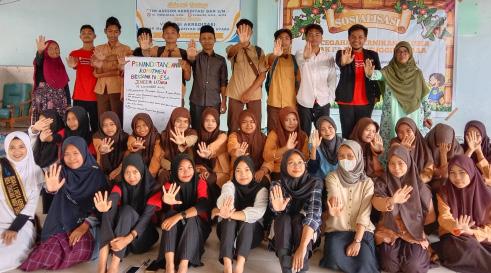
the national stage, reading her poems in front of government officials during public events, urging them to pay attention to the lives of Indonesian children.
Together with her friends, Minha sought to champion the rights of both women and men, and raise more awareness on gender equality in her village. Through speaking at schools, conducting research, producing pamphlets, videos, creative campaigns, and festivals, and forming a children’s forum with the support of the village government, little by little, change was brought.
That’s what I want to change the most - [that] education is not just based on our biological or gender differences as girls and boys.
Parents, who were initially reluctant to let their children join organisations, came around when they saw how their children developed and utilised their voices. The village’s children’s forum works with the local authorities to intervene when there are anonymously reported cases of child
sexual partners is a wonderful way of testing your limits and determining your preferences, when your phone doesn’t buzz or they refuse to acknowledge you in a seminar, a certain loneliness can ensue. Not everyone wants an intimate connection with a sexual partner, and it goes without saying that sex is not the only way to be intimate with a partner and establish a connection, but when there is a lack of clarity and communication in the matter people can get hurt. It is perfectly fine to want no strings attached sex, and it is equally fine to have several partners in order to find the one that is just right, but perhaps having a conversation with your sexual partner(s) about how you both feel could be the difference between leaving things on good terms and the slump that follows radio silence.
Know that you should never, ever, have sex unless you are both comfortable and safe!
marriages. Additionally, now students at Minha’s university often discuss and debate on issues of gender equality.
Nevertheless, there is still the need for more improvements.
“For my village, I hope that people will be more open to issues around gender equality. And I hope that people can understand what gender equality is, and not misinterpret its meaning – [thinking] that only women will benefit from gender equality.”
Though occuring in divergent places, the fight for gender equality is at its core, the same. In both the Global North and South today, women are often still deemed as inferior to men, silenced, and restricted. Yet in both places too, there are exceptional women like Minha, burning with passion, using it as fuel to fight for gender equality, and bringing change to their communities, both big or small. It is only because of their efforts that we have the change we see today.
Whether you have sex lots or not at all, remember sex will never be as interesting as you!
Regardless of your stance on casual sex, or sex in general, one fact still remains, chiselled on the Rosetta Stone, etched into the Dead Sea Scroll, and probably the Bayeux Tapestry; your relationship with sex does not reflect your worth under any circumstance! Your body is something that stays with you from your first day on earth until your last, treat it, but also protect it, and as physical as sex is, the effect it has on your mentality can be just as detrimental. Whether you have sex lots or not at all, remember sex will never be as interesting as you!
Neurodivergence is an umbrella term encompassing different thinking styles that influence how people respond to the world. Although conditions such as autism and ADHD are more commonly discussed, neurodiversity also includes dyslexia, dyspraxia and dyscalculia. In the last few years, there has been an increase in the number of posts and videos centred on neurodiversity on social media platforms. On TikTok, a site popular with a young and therefore impressionable demographic, a search for “#autism” produced over two million videos, while over three million videos were hashtagged “ADHD” (as of 1 March). Instagram, rightly, also allows for users to search for these terms, and, perhaps because it has been around longer than TikTok, it has acquired an even higher number of posts related to these diagnoses. Interestingly, despite several symptoms of both ASD and ADHD being debilitating and leaving many young adults unable to work, Instagram has not shadow-banned the aforementioned hashtags. Whereas it is impossible to search for terms such as “depression” without the app continuously asking if it can help me, in the manner of an annoying Lush worker.
The prevalence of these terms on social media has created somewhat of a feedback loop: users that initially considered
themselves neurotypical stumble across a post about autism (easy when Instagram has over 13 million of them), recognise a symptom or two within their personality, self-diagnose, and finally post a video about autism on their own account. While there are obvious issues with diagnosing oneself with a health condition, be it mental or physical, I am not always against it when it comes to neurodiversity. The post-Covid NHS is in such dire straits that the only way to receive an appointment when you need one nowadays is to ask a fortune teller when in the next year you’re going to be ill and book six months in advance. I’ve been waiting for 41 weeks now to see an ENT (ear, nose and throat specialist) after being
referred by my GP last year. If I’d engaged in some post-appointment unprotected coitus, my new baby would have had their ears, nose and throat checked before mine. The situation is even more depressing for those waiting to be reviewed for autism or ADHD – it can take up to three years for a patient to be seen. The circumstances are also particularly challenging for young women, who tend to grow up masking any neurodiverse traits, and often get misdiagnosed with conditions such as BPD.
However, social media has also brought about an influx of armchair psychology, or in 2024 terms, Bed Rotting Psychology, in which the behaviour of celebrities is analysed in depth and A-listers are

bestowed a diagnosis of neurodivergence. Jenna Ortega innocuously claiming she likes to chill indoors? Autism! Billie Eilish asking a muffled talk-show audience member to repeat a poorly-phrased question? ADHD, for certain! I’m not outrightly denying that they have symptoms of these diagnoses – hell, they may well have the conditions – but Swiftie2006 and the like are not psychiatrists, don’t know Ortega or Eilish personally, and, perhaps most importantly, fail to acknowledge that one or two symptoms of something does not a diagnosis make. If that were true, I would have a chest infection right now, when in reality, the discomfort in that region is due to my decision to wear a bra purchased six years ago for the whole day.
In Model UN conferences, students represent their assigned country’s position on real world problems
It is ironic that this week (18 March –24 March) is Neurodiversity Celebration Week, yet content creators’ constant scrutiny of people’s likes, dislikes and interests is not a cause for a party. Come to think of it, I don’t like parties much. All those people trying to talk to me; the loud bangs as balloons continuously pop; the texture of the birthday cake…oh. Maybe TikTok was right after all.
Abbie Brown Staff Writer
On 23 - 25 February, the University of Sussex Model United Nations Society attended the London International Model UN conference (LIMUN). In LIMUN’s 25 years, it has certainly built prestige, becoming Europe’s biggest Model UN conference. It draws approximately 1500 university students from more than 50 countries to participate in academic simulations of UN bodies called committees.
In Model UN conferences, students represent their assigned country’s position on real world problems
In Model UN conferences, students represent their assigned country’s position on real world problems and solutions in debates, gaining insight into UN functions and diplomacy. As part of LIMUN’s aims to inspire young people to become leaders on global issues, diplomat guest speakers are integrated into the conference program.
The location of opening events in Central Hall Westminster - venue to
the first UN general assembly in 1946 - added significance to the occasion. Students presented questions to a panel of diplomats representing Australia, Canada, Finland, Mexico, Switzerland, and Austria. A noted Sussex favourite was the controversial Mexican ambassador to the UK, who was demoted as a minister for her unauthorised use of presidential powers to delay a commercial flight for her personal lateness. The event provided us with the surprising opportunity to meet and network with her, albeit by chance in the lobby. She spoke to us eagerly about her desire to hear from young people; as much as diplomats talk, she emphasises the importance of listening. She gave us business cards, saying we must meet her for tea and Mexican food. It’s uplifting to hear politicians listen to what students really want.
Throughout the conference, guest speakers and panellists repeated calls for young people to participate in politics and rise up as future leaders, specifically regarding climate change. Connected most strongly to this climate theme was a speech and Q&A by Conservative MP Alok Sharma, in which he recounted challenges as COP26 President in Glasgow, discussing his views on climate policy and
the importance of global cooperation. Sussex student Jack Campbell raised a question about the link between Sharma’s former finance career and his assertion of the necessity for private investment in climate change initiatives. Sharma’s answer disappointingly repeated both facts. In light of this exchange, and upon learning previous years’ guests included a former UN General Assembly President and Angelina Jolie, the Sussex Delegation grew slightly jealous.
The eleven Sussex delegates put this inspiration into action in a range of committees: the economically focused ECOSOC and ECOFIN, regional committees Arab League and Organisation of American States, climate change-focused UNFCCC and UNEP, and specific issue committees Legal, WHO, and SPECPOL-Decolonisation. Three days built to attempting to pass resolutions, with the majority of us succeeding - an uncommon feat!
The closing ceremony presented awards to the best-performing delegates of each committee, and further inspired with an address from a Hult International Business School director. First seeming to buck the optimistic trend, declaring “the world is a horrible, destructive, and messed-up place”, the speech then implored listeners
to turn this sentiment into action, asking ourselves “will we [...] do what we can to try and make the world a better place?”
After all, in the pursuit of pretend world peace, surely that’s what really matters?
The Sussex participants feel robbed of formal recognition, but the lack of trophies was remedied by better peer recognition within our committees. This came with sweeping gains in joke ‘superlative’ awards, with highlights: Most Likely to Become a Dictator - Denmark; Most Likely to Lead a Protest - Saint Lucia; Best Hair - Tanzania; Best Dressed - multiple. A second form of recognition came with Denmark’s inter-committee fame for speeches with “Michelin star chef level cooking”, per a note passed by Thailand.
The Sussex delegation may not have won any official awards, but we certainly won the hearts and minds of the people in our fellow pretend diplomats. After all, in the pursuit of pretend world peace, surely that’s what really matters?
MUN Soc meets on Wednesdays 4:00pm-6:00pm in Fulton 214.
Zeeshan Tirmizi, Laura Mellena, and Ray Das Staff Writers
Whistleblower journalist and WikiLeaks founder Julian
Assange’s two-day trial began in London on 20 January at the Royal Courts of Justice. It is one of the most significant cases of press freedom of our time. The hearing will decide whether Assange is extradited to the United States and imprisoned for 175 years, potentially even facing the death penalty. The Badger’s writers took to the streets to witness firsthand how the case unfolds.
The street outside the court was flooded with activists, journalists and members of the civil society. Representatives from journalist organisations such as the International Federation of Journalists, Reporters Without Borders and the National Union of Journalists joined the demonstration outside the court to support Julian Assange.
Julian Assange, with the help of former US soldier Chelsea Manning, leaked many confidential CIA documents, which exposed the US role in the Iraq and Afghanistan wars as well as the Guantanamo Bay detention camp. Assange’s investigative journalism eventually put him behind bars. After Ecuador removed Julian’s asylum while he was in the UK, the London police arrested him. Addressing the press on 20 February, Stella Assange (Julian’s wife) exclaimed: “There is no possibility of a fair trial if Julian is extradited to the United States’’. She further alleged, “This case is an
Iadmission by the United States that they now criminalise investigative journalism. It’s an attack on journalism and journalists all across the world.”
British politicians attended this hearing in solidarity with Assange. Labour MP Jeremy Corbyn expressed his concerns about the deterioration of Julian’s physical and mental well-being. Corbyn called the prison “an awful place under awful conditions” and wished the prisons to be “supportive, corrective and reformative.” He also acknowledged Assange’s bravery by emphasising that “real journalists take risks”. Coventry South MP Zarah Sultana showed her support: “Revealing war crimes is not a crime; it is journalism. It is what we
Image: Zeeshan Tirmizi.
say when we talk about speaking truth to power.”
One protester revealed that every Monday she attends a similar protest in Brussels. After hearing that we were interviewing for a student newspaper, she expressed that she has high hopes for students bringing out the truth. “Back when I was a student,” she recalls, “we never had to ask for permission to protest for something. We would just go out and do it.” In light of the Assange trial and the government’s attempts to impose stricter laws on the recent protests against the conflict in Gaza, the protesters emphasised that “universities should be a place for free speech.”

The amount of protesters and the presence of many journalists, politicians and public figures were evidence of the importance of this case and its implications for the freedom of the press. Despite the downpour, many people attended the trial’s second day as well, which WikiLeaks named the “Global Day X”.
Assange will forever remain an inspiration. His work is an example of what real journalism should be.
Assange’s life has been significantly affected by this 13-year-old case against him, evidenced by his wedding day where bride-to-be Stella Assange walked down the aisle… inside Belmarsh Prison. Even more concerning is that Assange is not allowed to attend these trials, which will decide his future. Ironically, it is Assange who is being persecuted for carrying out his journalistic duty and exposing human rights violations whilst the true criminals are still roaming free. The outcome of this trial might be announced in March but the predictions are not looking hopeful.
Years after the documents have been leaked, the US still refuses to take accountability for their atrocities, even when the whole world knows the truth. If this prosecution aims to scare journalists, then the US and UK governments are failing miserably. Even in the case of an extradition, Assange will forever remain an inspiration and his work is an example of what real journalism should be. True journalists will never be silenced.
nspired by Daniel Ellsberg’s release of the Pentagon Papers in 1971, Julian Assange and a small group of journalists, mathematicians and political activists co-founded WikiLeaks. As per its website, WikiLeaks describes itself as “a multinational non-profit media organisation and associated library that specialises in analysis and publication of large datasets of censored or otherwise restricted official materials involving war, spying and corruption.”
Over the years, the organisation has released several document caches and media exposing the severe human rights violations carried out by various governing bodies across the world. Their earlier exposés include US 2002 drone strikes in Yemen (which are currently ongoing) following the 11 September 2001 attacks; extrajudicial executions by Kenyan police leading to violent clashes and deaths during subsequent elections; and the 2007 release of the US Army manual of standard operating procedures overseeing
Al-Qaida suspects held in Camp Delta in Guantanamo Bay, Cuba.
Most significantly, in April of 2010, WikiLeaks, released footage from Baghdad airstrikes carried out by the U.S. military on 12 July 2007. Titled Collateral Murder, the clip showed soldiers in a helicopter fatally shooting 18 civilians. This particular video was one of several files and media shared by former Army intelligence analyst Chelsea Manning who was arrested in May 2010 and court-martialed for leaking the video and downloading classified State department documents. Material shared by Chelsea Manning also includes videos of the 2009 Granai Massacre in Afghanistan carried out by the U.S. military and the exposing of Afghan war logs, with 76,910 army reports of US military intelligence detailing the undisclosed civilian casualties and grim details of the Afghan War. In October of the same year, WikiLeaks was complicit in the biggest leak in the military history of the United States: the leak of Iraq war logs. Composed of 391,831 army
reports detailing the Iraq War from 2004 to 2009, it revealed the destruction and alleged war crimes of the US. Over the next several years, WikiLeaks went on to publish Guantanamo Bay files, the Syria files, the Kissinger cables, the Saudi files, Vault 7, and many more such leaks.
WikiLeaks describes itself as “an organisation library that specialises in censored official materials involving war, spying and corruption.”
Assange’s activities were finally brought to government attention when, in 2012, Assange was offered political asylum in the Ecuadorian Embassy in London to avoid extradition to Sweden. This was later withdrawn in April 2019, leading to his subsequent arrest. Assange was remanded to Belmarsh Prison for 50 weeks of imprisonment on account of breaching bail. He is still there today.
At the same time, an indictment was filed against Assange, where he was charged with conspiracy to commit computer intrusion regarding his involvement with Chelsea Manning between 2010-2011.
According to the official press release from 2019 provided by the US Department of Justice (DoJ), Assange was charged with an 18-count superseding indictment which alleges that Manning and Assange conspired together to unlawfully obtain and disclose classified documents to harm US foreign relations. All charges against Assange carry a maximum sentence of 175 years. A second indictment in 2020 claims the prior indictment “broadens the scope of the conspiracy surrounding alleged computer intrusions” with which Assange was previously charged in 2018. The US DoJ further accused Assange of encouraging and recruiting other hackers to gather information for his organisation.
In 2021, the High Court of Justice in London ruled that Assange may be extradited to the US.
Namse Udosen Staff Writer
Nigerian students are a significant part of the Sussex community, bringing a lovely energy wherever they go on campus or in the city. Oghenechovwe Okolosi (nicknamed OG) has it in abundance. A sustainability lover and accountant, he is also a big-time fan of Bob Marley and reggae music. I recently met him to chat about his campus experiences and activities.
On why most people on campus call him OG, it isn’t his preference. “But I love that ‘OG’ sounds sleek and saves people the stress of pronouncing my name –‘Oghenechovwe’ correctly. I don’t enjoy seeing people struggle, especially with pronouncing my name.”
Known as the Marley Man on campus, OG has a passion for reggae music and its influence on his living. “It has improved my campus experience in terms of building and maintaining diverse relationships and fostering a peaceful coexistence within the various campus communities I belong to. It has been a bridge to connect with Caribbean students”.
“The message of unity, social justice, and resilience is universal. It is one that people across every race and background can resonate with,” OG said. “You can see how some students have resiliently protested in front of the library, calling for a ceasefire in Gaza. You can see the support it has drawn from diverse backgrounds. I
am sure the message from Culture’s World Peace and Bob Marley and the Wailers’ No More Trouble resonate these struggles.”.
As a sustainability enthusiast, OG has been a volunteer of the Food Waste Café. “I have been mainly involved in setting up the weekly stall, attending to donors during stall days, and picking up deliveries from FareShare at the Meeting House”.
“Through its partnership with FareShare, the Food Waste Café helps to address some of the Sustainable Development Goals (SDGs). For instance, food items given for a minimum donation of £0.50 help students get food items cheaply, thereby addressing SDG 2 – Zero Hunger.
The model adopted by FareShare with large retailers allows them to get food donations for food items that these retailers would have wasted. These food donations are then distributed to its partners like Food Waste Café. It helps prevent food waste, which releases methane when dumped into landfills, hence helping to reduce greenhouse gas emissions and address SDG 13 – Climate Action,” OG further explained.
Let people make the effort to learn to pronounce names from other cultures. “
In his observation, OG noted that the university can take better steps in representing diverse culinary traditions. “Despite the large population of African students on campus, it is somewhat surprising that the cafés and restaurants

do not represent this,” he mentioned. “While I commend the University of Sussex for its immense efforts in empowering a diverse campus, it is quite disappointing not being able to buy jollof rice on campus. Of course, I understand the challenge in terms of the cost. However, I believe there is much the university can do”.
While it has been a struggle to get accustomed to British cuisine, OG found ways to bring the taste of Nigeria here.
“I do a lot of cooking. I came with some local spices from Nigeria, and, to be fair, Brighton has some really good African shops. They have been a lifesaver.”
As a sports fan, the Marley Man admired the camaraderie in the local campus community. “The Sussex Chevening community was able to organise a viewing for the final of the African Cup of Nations football tournament hosted by Ivory Coast. The University of Sussex supported us with about £89, which went into prizes for winners of the various prediction categories. In the future, the University can be more proactive in keying into events such as the AFCON to underscore its commitment to diversity further.”
“The banter was crazy in the Chevening Sussex community. I commend the Northfield Bar for consistently televising the matches of the African Cup of Nations, especially during the knockout stage. This just demonstrates Sussex and the Student Union’s commitment to diversity,” OG recalled.
The conversation with OG opens memories of my early education in Nigeria and how we were made to learn proper pronunciations of foreign names. I feel people should not get uncomfortable when others perceive their names as difficult. Let people make the effort to learn to pronounce names from other cultures.
The food narrative also speaks to me. As a Nigerian, food is not just a form of nourishment, it’s a ritual of identity. We could do with some Jollof rice and Afang soup on campus.
Ilana Munk-Upton Staff Writer
The University of Sussex has a reputation for being modern, forward-thinking and progressive. Yet its teaching of feminism in its politics degree, and elsewhere, is severely lacking. Coverage of feminism as an ideology is sparse and barely has its own week in most modules. When it is covered, it is done so from a historical perspective, which implies the fight for feminism is ‘won’ or an issue of the past. However, as we all know, that is certainly not the case - with the rise of figures such as Andrew Tate and Jordan Peterson plastering the social media feeds of men everywhere, poisoning them with misogynistic and toxic masculine rhetoric. The popularity of these men no doubt coincides with the fact Gen Z men are less likely than Millennial and Gen X men to identify with the label of ‘feminist’ and more likely to agree that feminism has
‘gone too far’ (look up the stats!). Therefore, it is the job of academic institutions such as schools and universities to not only arm women with the tools and knowledge to stand against this new wave of misogyny, but also to educate men that the patriarchy negatively affects them as well and they too should be feminists.
This is the line of argument I used when talking to one of my senior lecturers. In his module about political theory, he didn’t include any dedicated week for feminism or even a mention of it. After emailing him my worries, he invited me to talk about it with him in person, so I did. Now, I’m not saying the conversation went terribly or that this lecturer meant to come across badly, but things were said that were uncooperative and dismissive. Let’s just say, being accused of “sneering” and “looking for disagreement” are probably not the most productive things to say to a female student when discussing feminism in an academic space. Despite this minor
hiccup, after the discussion I left with a feeling of satisfaction as I stood my ground and he genuinely seemed receptive to what I was saying. Progress, right? Well, yes and no – on the one hand, I came away feeling listened to and respected (somewhat) and that my criticisms had been acknowledged. But on the other, why was it so hard to get there in the first place? And why was certain language used to frame me as being overly emotional and illogical?
“
Academic institutions should not only arm women with the tools to stand against this new wave of misogyny, but also educate men that the patriarchy negatively affects them too
As I’m sure most of our female readers know, specific language is used against women in arguments or debates to undermine what they are saying due to the
supposed or actual presence of emotion. This tactic is damaging as it is used predominantly against women, especially concerning matters of feminism. What most men don’t understand is that the objectivity they present and value in discussions like this is actually a privilege and should be recognised as such. The frustration of having to plead with your lecturer for female representation, noticing men talk more than women in your seminars (again statistically true!), and having men speak over you in group situations are all issues that are so incredibly personal and warrant an emotional response. So, do I feel it was right for me to be critiqued in this way by my lecturer? Absolutely not. My main purpose of writing this article is to tell other women that it isn’t okay if it happens to them either - and to push for more education on feminism. Hopefully, education will empower women against the multiple barriers facing them in academic spaces.
Zachary Morris Staff Writer
The University of Sussex takes pride in its recent position as the 8th most sustainable in the UK, alongside its vision to become one of the most sustainable universities in the world. While its strategy focuses primarily on decarbonisation and environmental impact, Sussex ensures the inclusion of a ‘socially responsible investment policy’ that promotes human rights and an end to international conflict. Ironically, Sussex places trust in external investment managers who are left at their discretion to select individual stocks, many of which are investments in harmful industries.
Once students complete their student finance plans, little information is given in return as to where this money is spent. Roughly 60% of the £380 million received last year came directly from fees we pay for higher education. It seems unusual that more of this money is spent on future investments than that on student wellbeing and widening access schemes. Keeping in mind the sustainable promises of our university, let’s take a closer look at
where student money ends up.
FOI requests from the Palestine Solidarity Campaign and student network People and Planet have named and shamed some of the industries Sussex invests in. This includes £200,000 in Puma and £100,000 in Siemens, companies both known to operate within settler colonial projects on stolen Palestinian land. Meanwhile, investments of £659,000 in Apple and £829,000 in Microsoft represent a technology industry that depends on child labour and genocide in the DRC to source its materials. While these examples demonstrate complicity in supporting genocide and dispossession, dissecting larger investments exposes a much deeper issue.
Higher-value investments that reside in multinational banks and investment management companies provide financial assistance to global military campaigns. For example, Sussex invested more than £60 million in Barclays and £20 million in investment manager BlackRock. Collectively, these companies support BAE Systems, Boeing, Caterpillar, General Dynamics and Elbit Systems (to name a few). In other words, they profit from
the production of arms, cybersecurity, drones, helicopters, missiles, demolition, border constructions and surveillance used to erase oppressed people across the globe. Unfortunately, Sussex’s ties with genocide don’t finish there. At first glance, shares in multi-billionaire companies such as Halma, a British safety equipment company, seem unrelated to such practices and concordant with the investment policy. However, it doesn’t take long to connect their origins as a colonial rubber estate in Sri Lanka with their accumulation of wealth today.
Investments by Sussex do highlight one form of sustainability; the ability to sustain genocide through greenwashing of imperialism.
It’s clear that the money we pay each year is not invested in the suggested sustainable utopia. Instead, the same system we place ourselves in for education uses the wealth we borrow for Sussex to preserve the very system we protest. It’s also important to note that the boycott
and divestment of selected companies is insufficient when the very economic institutions our society depends on to function continue to accumulate wealth through the exploitation of land, labour and resources.
The Dell library computers (I used to write this piece) are also linked to genocide in the DRC. Similarly, campus services such as Costa, owned by Coca Cola, continue to operate on stolen Palestinian land while donating supplies to the Israeli military as part of their 57-year support of the apartheid state. Let’s not forget that the university itself was founded via royal charter, a grant provided through wealth stolen by the British Empire. Furthermore, the performative push to decolonise seems insignificant in the face of economic aid for neocolonialism. Investments by Sussex do highlight one form of sustainability; the ability to sustain genocide through the greenwashing of imperialism. We cannot focus on policies of climate justice when our university has not been held accountable for complicity in genocide and social injustice.
Charlotte Berry Comment Editor
As a first-time voter, I need help understanding what is happening in the often paradoxical world of politics. This is why I joined a panel of firsttime voters on BBC 5 Live. Isabella (our lovely Arts Editor) and I had the privilege of speaking with Dotun Adebayo (BBC presenter) about the upcoming general election. We debated with fellow first-time voters, as well as those who have frequented the polling station. The overarching theme in our conversations was; do we vote for the party, the leader, or the local MP?
The “Rishi recession” could suggest that voting Labour is the perfect strategy for ousting the Tories.
Recent by-election losses have left Tories reeling. Conservative safe seats, often called Bellwether seats, have now been refurbished with lovely Red cushions. The Conservatives have now lost a total of six seats in ten by-elections in this parliament, the worst record of any government in the past 50 years. Now left standing, the Tories have nowhere to hide. Public scrutiny of the Conservatives is at an all-time high. Tory scandals such as “Party Gate”, the cost of living crisis, and Rishi’s greed for North Sea oil have meant that our beloved government has left a
less than positive impression on the general public. Whilst the recent by-elections do not guarantee that the Tories will lose the general election, clearly there are trends in voting patterns that may suggest that they’re on the outs. But if we are so disillusioned with the party, perhaps it is better to vote for the leader or the local MP.
The “Rishi recession” could suggest that voting Labour is the perfect strategy for ousting the Tories. When asked by Dotun Adebayo if Labour are the “lesser of two evils”, it initially seemed to me that they are. In a poll by ITV in May 2023, named “Youth Tracker”, up to 60% of 18 to 24-year-olds said they would vote Labour over any other party, compared to just 15% saying Tory. Has the “Red Wall” finally fallen? Labour obtained landslide victories in Kingswood and Wellingborough local elections in February 2024. Both constituencies have historically had a Tory MP and do not fit with the stereotype that Labour is exclusive to the North of England.

Image: BNN Bloomberg
The appeal of the Labour Party promises such as boosting the economy, promoting equal access to education, and better housing sounds like a student’s dream. However, recent controversy has implied that Keir Starmer is in support of Israel’s “right to defend her people” against the oh-so-threatening children of Gaza. At Labour’s annual conference in Liverpool
on 10 October 2023, just three days after the beginning of the Israel-Hamas conflict, Starmer called for increased funding to humanitarian aid in Gaza but was very clearly against a ceasefire. Ironic, seeing as Starmer claims that “innocent lives must be protected”. If the leader is contradicting his pledges for social justice, do we still vote for the party he represents?
If the leader is contradicting his own pledges for social justice, do we still vote for the party he represents?
We also cannot forget that we are Brightonians. Brighton has historically voted Green in local by-elections, it holds the first and only Green seat by Caroline Lucas since 2010. Green campaigns hard on local issues; they focus heavily on climate protection and improving the rent crisis through council-led schemes. Beyond environmental issues, Lucas
has been a vocal advocate for LGBTQ+ rights. It is no surprise that Brightonians favour green policies over the socially and environmentally un-conscious ones of their competitors. Does it make more sense to vote for the MP? After all, the more seats that are taken by Green, the less they are taken by bumbling Eton alumni and possible Zionists. But it isn’t very likely that Greens will lead our country this time around. In a conference in Brighton in October 2023, Party co-leaders Carla Denyer and Adrian Ramsay claimed that Green is only seeking to obtain four seats in this general election.
Whilst this may seem like a very long and boring game of musical chairs, it is important to understand that this will have real impacts on the quality of living of the general public, and the UK’s footing in international politics. Young people have always been involved in politics, whether that may be through social media, debates in classes, conversations at the family dinner table, or banter at the pub. For many of us, including myself, this is the first time in which we have a real platform to voice our opinions. We mustn’t waste this opportunity. Isabella and I will be returning to BBC 5 Live in the coming weeks to further discuss the trials and tribulations of our government, keep an eye on @thebadgersussex on Instagram to stay in the loop!
Jack Timmins Staff Writer
here are too many attractive students. There. I said it. Young people in Brighton seem to be in relatively good shape and have decent, luscious hair or even beautifully unkempt, rugged, wild hair that somehow enhances them. There’s an apparent absence of insecurity; a confident swagger which comes from knowing that you are looking good. Coming from a small town, I hardly knew or saw these types of people. Now, here in Brighton, I have noticed that there is an increase in the general standard. Average seems to be the exception and it is rather unsettling.
It is a completely new feeling. My town has a population of roughly thirty thousand - Brighton has a quarter of a million - and even then, the number of people that are the same age and sex as me is even smaller. Before university, people looked normal. Plain. Harmless. No one looked particularly ugly or bad, but they did not look like an Instagram model or celebrity. They just looked ordinary. Of course, there were always beautiful people, and I would have crushes and feelings of attraction, sprinkled with occasional jealousy of a
guy’s style, or a girl’s clear skin. Now, I find myself feeling SO bloody insecure. Let me be clear, I have always been relatively confident - I don’t wake up hating my body and I’m pretty OK with myself as I am. There is just a noticeable, lingering feeling of inadequacy.
Frankly, I am jealous of them. I’m not resentful, I know I’m being shallow. But if a friend was telling me that they’re comparing themselves to others, and have this lingering feeling that they’re not as good as everyone else, I’d slap them out of it! (Figuratively). I'd remind them that it’s pointless - a menial reduction that achieves nothing. Attraction and beauty are subjective and, honestly, irrelevant. A kind heart and sharp mind are what matter more than preconceived ideas of beauty.
Despite this, I can’t deny, I WISH I was beautiful.
Perhaps part of this feeling comes from the emphasis on the “uni experience”. This isn’t just personal freedom from nosey parents, rigorous school/college schedules or paid work. It is sexual freedom, particularly if you’re queer and haven’t had an opportunity to meet other queer people before.

Now you’re in Brighton, you’re presented with countless opportunities and experiences. But the wild nights out and partying have a subtle undertone of competition. There is a need to ensure that you look good enough to be included, even if you don’t want to take part. It’s an awareness that to be acknowledged among your peers, you have to look good.
Because they do.
The thought of reducing everyone down to what they look like is upsetting. It’s an objectification and ranking but it’s not to degrade them, rather, it’s to compare them to myself. There is a sense of competition, of alienation, of the “other”. It’s lonely. It goes against everything that university should be about; wanting to achieve, gain a greater understanding of the world and come away a better person. Not to come away with a sense of disillusionment from seeing what the competition is. A “me versus them” mindset becomes isolating, which also affects friendships. I find myself objectifying them and focusing on their looks. Reducing people to a sliding scale of attractiveness. A ranking system of which to compare myself to. It has noticeably gotten worse since being in Brighton.
While I was prepared for new feelings and experiences that come from university, I did not expect to feel this imposter syndrome, even within academia, the lecture hall and seminar room - places where your arguments and ideas should define you, not your appearance. And yet, I find myself doing just that. I can’t be the only one, and I do wonder if now at university anyone else feels ugly.
Whereabouts are you studying at the moment, Lucy?” asks a friend of my parents/nosey landlord/overly-friendly Uber driver. My heart sinks, knowing I’m about to rehash a conversation I’ve had about 100 times since beginning my BA back in 2018.
“In B…B…Brighton,” I stammer in response, knowing that they’re about to unconvincingly wax lyrical about the University of Brighton, its campuses at the diseased heart of the city, and the relaxed approach to teaching. Part of the reason I panic is because I, too, harbour an irrational yet deep-seated prejudice against our neighbouring school, but I also fear being thought of as a snob. So I don’t want to monologue to a cab driver that while, yes, I am living and studying in BN1, I am attending the far more prestigious University of Sussex. I now just order Ubers from Refectory Road; it’s easier that way.
The rivalry between Brighton and Sussex is a fairly new phenomenon –chiefly because both institutions are relatively new. Though Oxford University is older than the Aztec civilisation (yes, really), the schools in East Sussex might just about be older than a tin of beans at the back of your cupboard. While the University of Brighton was founded a whopping 166 years ago (as Brighton College of Art), it only received university status in 1992. The University of Sussex,
on the other hand, was granted university status in 1961, making it a boomer to Brighton’s millennial-disguised-as-aGen-Z.
This is a fitting description considering the characteristics of the scholars at the two establishments: some of our alumni and faculty love to brag about their accomplishments, and look down upon those on the come up. I recently had a guest lecturer boast about Sussex’s renowned research-intensive status and, in the same breath, patronise a “local university” whose ethical approval forms are, apparently, not as…um…ethical as ours. Additionally, I’ve also witnessed toilet paper in the University of Sussex’s library defaced with the words, “a 2:1 from Brighton”.
The University of Sussex was granted university status in 1961, making it a boomer to Brighton’s millenial-disguised-as-a-Gen-Z.
Not only are these incidents immature and condescending, but ick-inducing when considering each university’s place on the Complete University Guide’s 2024 league table. The catalogue, which takes into consideration entry standards, student satisfaction, research quality, and graduate prospects, ranked the University of Sussex number 50 in the UK, and our rival number 68. Our snobbery is particularly embarrassing because Brighton managed to climb 13 places
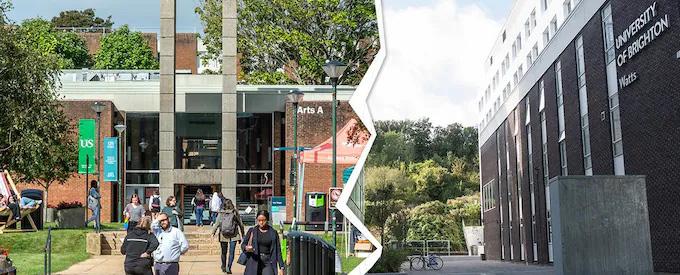
in the chart since last year, whereas we dropped by nine. The University of Brighton also scored higher than us in terms of graduate prospects, but at least we’ll be able to brag about our alma mater to the staff at the JobCentre, right? And, let’s be real, neither Sussex nor Brighton holds Oxbridge status. Our rivalry is more Bolton Wanderers vs Wigan Athletic than Arsenal-Tottenham.
My partner, Ryan, is a graduate of the University of Brighton, making our relationship a modern adaptation of Romeo and Juliet. In response to my asking him why he chose Brighton over Sussex, he responded, “Brighton’s Broadcast Media course at the time seemed a lot more practical than what Sussex was offering. I knew in the back of my mind it had a worse reputation in terms of academia, but that didn’t matter to me since I wasn’t too interested in conducting research or writing a heavy dissertation.”
After graduating, Ryan began working
in the industry, creating films for the NHS, proving that graduate outcomes are not dependent on a university’s league table position. Basing your choice on league tables is as ridiculous as hitting up the palm readers on Brighton Pier so they can tell you where to go. You might as well make your decision based on the acceptance letter received by the other member of a doomed situationship. League tables fluctuate! How some of us are treating Brighton students is perhaps how the Oxbridge community would treat us. While I chose to come to this school for the beach, I don’t need the sea to feel waves of inferiority wash over me every time I remember that SPA’s Best Journalist of the South-East region was an Oxford scholar. And let’s be real - updated league tables mean new generations of Sussex students are in no place to look down at the University of Brighton. Doing so makes Sussex seem like the boomer she is. So let’s stop now.

Aries (21 March to 19 April): With the sun in Aries from 20 March through 18 April, you’re the main character. The total solar eclipse on 8 April calls you to be unapologetically yourself; independent and assertive. Try extra hard to stop and think before you blow up when Mercury goes into retrograde in April. I know it’s hard. And try not to get too mad at me if this isn’t accurate.

Taurus (20 April to 20 May): Aries season sets the stage for everything you have been working towards so far this year. Good thing you’re patient; you’ll have to wait until late April for Jupiter and Uranus to join forces in Taurus and bring unexpected luck and fortune. Avoid serious financial commitments while Mercury is in retrograde. Yes, Taurus, this includes spoiling yourself.

Leo (23 July to 22 August): You’re full of vision and inspiration, and the sun in Aries mirrors the perfect time for you to take active steps to bring your dreams into reality. You may step into previously unexplored areas of yourself and unabashedly pursue your desires. You yearn for independence, but beware of burning bridges you might regret.
Virgo (23 August to 22 September): You may be contemplating a career or life path change, and the 8 April solar eclipse may bring some needed mental clarity surrounding this. Your romantic life may also be tumultuous, as you feel the acute need for love and connection. Open up to your friends, Virgo. They’re much less critical of you than you are of yourself.


Sagittarius (22 November to 21 December): Aries season encourages you to defrost last year’s selfimprovement efforts, creative projects, and drunken holiday plans. Although you may struggle with maintaining commitments and concentration, you can rely on your chosen family for support. Your desires are not out of reach, Sagittarius. They just require consistent effort.


Gemini (21 May to 20 June): Although this is an excellent time for self-reflection, Geminis should avoid overintellectualizing their feelings and nitpicking small details in others when Venus joins Mercury in Aries on 5 April. You simultaneously yearn for freedom and loyalty. Overcome your shyness and embrace confidence in communication (bring out your inner yapper).


Cancer (21 June to 22 July): The solar eclipse on 8 April shifts your focus towards your longterm commitments and priorities, particularly regarding your career or professional opportunities. You may feel overwhelmed by your emotions but don’t allow them to rule you entirely. Avoid impulsive decisions that may be urged on by the sun, Venus, and Mercury joining forces in Aries.
Libra (23 September to 22 October): The full moon and lunar eclipse in your sign on 25 March mark a key turning point in your partnerships and romantic relationships, and may illuminate a positive new beginning for you. Be careful not to lose yourself in your relationships. Remember your own needs.




Scorpio (23 October to 21 November): Scorpios may feel emotionally unstable leading into April after Pisces season has left you longing for a sense of security. Instead of self-isolating, look for an outlet for your nervous energy. The patterns you set now will especially influence your development over the next two years.
Capricorn (22 December to 19 January): Try to control your urges to fix everyone’s problems around the 8 April solar eclipse. It’s not your fault that no one else can hold it together like you. However, you might find yourself unable to relax or detach from your work and responsibilities. Allow yourself to have fun without judgment.

Aquarius (20 January to 18 February): One of the signs most affected by the 25 March full moon, Aquarius placements may experience a new awareness or emotional truth around this time. Personal growth is not always comfortable. Come back down to earth and take care of the physical realm towards the end of Aries season and leading into the 20 April Jupiter and Uranus conjunction in Taurus.
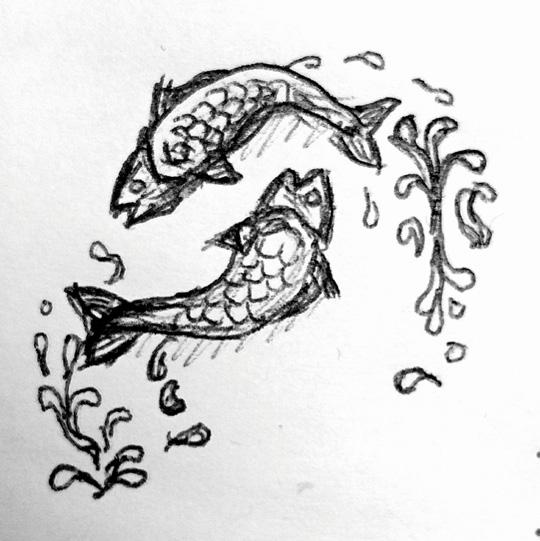

Pisces (19 February to 20 March): You may be feeling intense pressure to figure out your life all at once. Make sure you are not inflicting it upon yourself. The Pisces new moon on 10 March is the perfect excuse to treat yourself. Remember to communicate your feelings instead of getting lost in them.
Paige Braithwaite Staff Writer
After meeting at university ten years ago and being each other’s rock for so long, How Not to Fit In by best friends Charlotte Mia and Jess Joy is the vital accompaniment for anyone trying to navigate their neurodivergence - or anyone interested in these experiences. This book is hugely affirming, inspiring, and encouraging in what life can be like for people with autism and ADHD, exploring how much society still needs to change. Upon meeting Mia and Jess in person, the engaging, warm nature of their book shines through. Their desire for change is palpable and they really stand out as people with inclusion and equality at the very heart of everything they do.
Has writing this book been transformative for you in any different ways than your social media platform?
Mia: We had to drag up things that we haven’t spoken about on social media. It’s been tough in that way but also healing. I think people who read the book will get a more well-rounded view of us as people compared to the snippets of social media.
Your inclusion of stories from other people really made it feel like a community-driven book. How did you decide to do this and choose what stories to include?
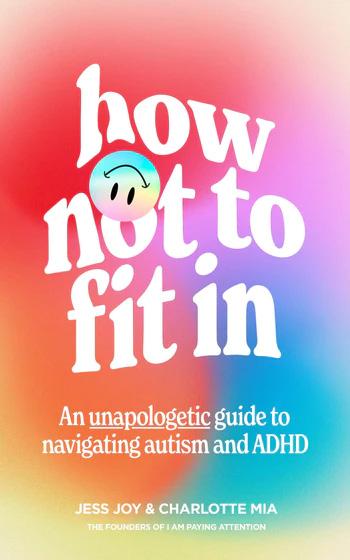
Jess: I think the way we’ve navigated social media has been more aligned with where we’ve currently been on our journey, sharing quite ‘in the moment’ experiences. But the book has more in-depth reflection, looking at things like trauma and how that can play into our experiences.
Mia: We weren’t ready for the trauma that the book was going to bring up, were we?
Jess: Definitely not! We had to think about what is going to serve the person reading this? How do we encapsulate everything we’ve learned?
Jess: While our conversation needs to take place about being neurodivergent in adulthood, we also have a level of privilege. Emmanuel Fru is a young Black autistic man from Sweden who was detained for having an autistic meltdown. We’re very aware that unmasking isn’t always possible or safe, especially when you are already being discriminated against in various ways. We never want to only centre our experience.
Mia: It was probably one of the biggest tasks of the book. Not only figuring out who to include but also how to do it in an ethical way, as we were restrained by our publishers in terms of navigating paying people for their time and stories. If we’re going to hear from minorities, we can’t and don’t expect free labour. I think both us and our publishers have learnt a lot from that process of questioning how things work.
You note in the book that autism referrals have tripled since 2019! What would you say to narratives that “suddenly everyone is autistic or has ADHD”?
Jess: I honestly don’t see how it could
possibly be a negative thing that more people are in tune with what they might be struggling with and what they need. Everyone deserves to navigate their existence with peace. So what if everyone is autistic and has ADHD? Why don’t we just create an environment that works for everyone a little better?
The book emphasises the importance of self-realisation for neurodivergence and how a professional diagnosis isn’t always the most important or only valid route. Could you touch on why you think this?
Jess: We are huge advocates of selfrealisation or self-diagnosis. Although we’re aware that a medical diagnosis means access to certain accommodations in certain settings, crucially there is nothing disordered about us. Many people also don’t have access to medical diagnoses due to discrimination or financial barriers.
What would you say to someone struggling like you were before you realised you had autism and ADHD?
Mia: It really helped me stop these cycles that I was constantly going through – whether it be relationships, work, or family – it was just avoidance, trauma and not coping. Suddenly I had context for these short unsustainable cycles and spinning plates and now I understand how to work on these different things. It’s not been easy or quick but now I feel like I have control over my choices, rather than just being reactive or surviving.
Jess: It’s not a short journey whatsoever and can be uncomfortable and understandably, there are people who avoid that feeling of discomfort. But longterm, leaning into who you are, what works or doesn’t work for you, and being able to melt away the shame is a peace that for such a long time, I didn’t even know existed. You can follow Mia and Jess on their Instagram @iampayingattention and buy their debut book How Not to Fit In published by HarperCollins. Head to thebadgeronline.com for the longer version of this interview!

Julia Uilenreef Staff Writer
Have you ever found yourself scrolling through social media, searching for inspiration to tackle your studies? If so, you may have stumbled upon the world of dark academia. Picture dimly lit libraries, tweed blazers, stacks of weathered books, gothic architecture, and classical sculptures. Dark academia is more than just an internet aesthetic; it is deeply intertwined with its own canon of literature. Donna Tartt’s The Secret History, a novel about intellectual obsession set against the backdrop of an elite institution, can be recognised as a cornerstone of the genre. Dark academia defies clear categorisation within literary genres, as its only core characteristics are that it must
(unsurprisingly) revolve around academia, as well as a focus on ‘darker’ themes such as moral ambiguity or the macabre. It can therefore be found in forms as varied as poetry and fantasy, a great example being Leigh Bardugo’s Ninth House.
Picture dimly lit libraries, tweed blazers, stacks of weathered books, gothic architecture, and classical sculptures.
Although the tag ‘Dark Academia’ originated on Tumblr in 2015, it is not an entirely new phenomenon, drawing inspiration from gothic and classical aesthetics. Still, dark academia has enjoyed a popularity surge in recent years,
peaking in 2020. The introduction of dark academia into the mainstream can possibly be attributed to the onset of the COVID-19 pandemic, where lockdowns and social restrictions caused individuals to seek inspiration online. Dark academia’s focus on nostalgia and intellectualism struck a chord during a time when life seemed to be ‘on hold’, making it challenging to maintain academic motivation. Additionally, the rapid growth of TikTok in 2020 facilitated widespread exposure to internet aesthetics, including the concept of ‘romanticising your life’. Unlike some internet aesthetics, dark academia offers accessibility in its romanticisation, through simple acts like lighting a candle or wearing a pair of plaid trousers.
Despite its undeniable appeal, dark academia is not without its criticisms. The
most popular literary works in the subgenre have been criticised for their Eurocentric focus (with characters exclusively studying Ancient Greek works or Shakespeare plays), and underrepresentation for people of colour. Amidst the discourse surrounding its shortcomings, there is a rise in new voices and perspectives such as Faridah Àbíké-Íyímídé who, in 2021, came out with the YA novel Ace of Spades, or R.F. Kwang whose novel Babel has become one of the most popular recent dark academia books. While evolving and adapting, dark academia continues to work as a motivating force for students and academics alike, fostering a passion for education and scholarly pursuits.
Yesenia Mahe Darlington Staff Writer
While perusing the shelves to find the next best read, one can often find sticker-like emblems on the cover informing the reader something of note about the book. For example, they can tell a potential reader it has been turned into a Netflix series, or that it is the winner of a literary award. Traditionally, a sticker related to an award would convey to the reader that through a rigorous and reputable process, the work is the best among its peers of that year. For the science fiction and fantasy genre, the Hugo Awards are understood to be the premier honour. However, after the 2023 ceremony, this long-standing reputation has been called into question.
It is procedure that after the award season, the members of the World Science Fiction Convention, who decide the final ballot, publish the statistics of the nominations. It is here where creators can see if they received any nominations and how many they were missing to be considered a finalist. Problems began to arise when the public noticed that the statistics were not released the same
night as the ceremony, as is tradition. It was only in late January 2024 when they were released, despite the event being held in October of the previous year. Social media was whipped into a frenzy when it was noticed that certain authors had amassed the necessary notations, but were disqualified from winning. Such authors included R.F. Kuang with Babel, Xiran Jay Zhao with Iron Widow, and Neil Gaiman with an episode of The Sandman Questions arose from the authors and public alike, as no statement was given as to why these works in particular were ineligible. No official answers were given by the committee; the only communications were done by Dave McCarty, the overall administrator of the awards through Facebook replies. He insisted that “After reviewing the Constitution and the rules we must follow, the administration team determined those works/persons were not eligible”. Despite many online users still being confused, and along with the authors themselves, the understanding of which rules were broken, and to what extent, was not further elaborated upon. McCarty quickly began berating anyone who challenged his original statement. Having been given no answers, people
began turning to more conspiratorial takes. A popular one being that a form of censorship was at hand since the ceremony took place in Chengdu, China. All three authors mentioned have voiced their displeasure with the Chinese government either through their work or online. Zhao responded to her fans with a TikTok video stating, “This is the first time that there’s been such blatant manipulation of the ballots… they have lost all legitimacy”. The Hugo Awards change its hosting location every year, and despite concerns, many saw it as an opportunity to reach new audiences and evolve into a less Westerncentric ceremony. However, answers came in the form of leaked emails from committee member Diane Lacey. While they may not have been pressured by the government to alter the ballots, forms of self-censorship still took place. McCarty wrote, “The laws we operate under are different… we need to highlight anything of a sensitive political nature in work”. He urged other members to highlight any works related to China, Taiwan, Tibet, Hong Kong, and general issues that might be deemed sensitive. The Western admins were the ones to spearhead this screening, but they were also in communication with the Chinese
admins. Zhao stated in a follow-up video that despite not only being Englishspeaking members who were guilty, “it does seem like they overcorrected in a racist way and ended up hurting mostly Chinese diaspora”. Lacey states she leaked the emails out of guilt for her role and as a measure to retract her actions.
This is the first time that there’s been such blatant manipulation of the ballots...
McCarty and others from the board resigned from their positions along with being censured for their actions and online comments. General consensus online appears to be one of distrust. Many believe that the response from the Hugo Awards is not enough to truly tackle the issue of censorship in an institution that seeks to exist outside individual governments. Additionally, science fiction and fantasy are the genres that are used to criticise political agendas such as censorship, and therefore, placating for the fear of retribution is disingenuous to the meaning of the awards. The legitimacy of the Hugo Awards is still being considered.
Published in 1890, The Picture of Dorian Gray stands as a classic among Gothic literature and explores society’s superficiality. Oscar Wilde’s creation of nuanced characters within a hedonistic, Victorian society exhibits the contemporary obsession of beauty, namely through Dorian and his relationship with the handsome portrait. Through a series of crimes and tribulations, the beauty of Dorian’s portrait begins to fade and bears the burden of his narcissistic actions, meanwhile, his external physicality remains young. Consequently, Dorian attempts to restore the portrait’s beauty by acting morally yet the portrait continues to grow uglier. Through the employment of an epigrammatic narrative, Wilde beautifully conveys the psychological depth of each character who simultaneously act as mirrors upon the contemporary society’s corrupted values. Despite critics highlighting the unrealistic, supernatural nature of the portrait, I believe this conveys the ability of our minds to paint implausible versions of ourselves in an attempt to reflect our morality. Nonetheless, as Wilde states, “the books that the world calls immoral are books that show the world its own shame.”

This remains my favourite fictional classic purely due to Wilde’s honest and obscurely brilliant thoughts on life that continue to exude philosophical relevance today.

Image: Atlantic Books
Gilda cannot stop thinking about death. In a desperate search for solace, she responds to a flyer for free therapy at a local Catholic church where she mistakenly stumbles her way into a job interview instead. As an anxious, atheist lesbian, Gilda is not the most obvious candidate to work in a church. However, she is abruptly hired to replace the recently deceased receptionist, Grace. In between memorising Catholic mass and hiding her Sapphic Hinge situationship, Gilda strikes up an email correspondence with an old friend of Grace’s. Unable to break the news of her predecessor’s passing, she assumes the identity of a dead woman. When the police come knocking, Gilda becomes increasingly tangled in a web of (albeit well-meaning) lies. Filled with morbid humour and a comforting warmth, Everyone in This Room Will Someday Be Dead is perfect for fans of Fleabag (although, Father Jeff cannot be described as a ‘Hot Priest’). Gilda’s journey is not a story of queer suffering. Or, perhaps more accurately, it is not a story of only suffering. Gilda gets to feel everything, from grief to love, affection and, ultimately, acceptance. For a book about death, it is surprisingly life-affirming and unfailingly kind. In the face of darkness and depression, people are all we’ve got. So we need to hold onto one another.
Literary Fiction: The Secret History
Donna Tartt’s The Secret History follows Richard as he navigates his way into a close-knit group of five classics students obsessed with Ancient Greek philosophy. They’re led by the selective and highly admired professor Julian, and under his influence, the group engage in morally questionable and obsessive behaviours. On the very first page, Tartt casually reveals that the group have murdered one of their own, Bunny, and the weight of their actions takes a toll, causing them all to unravel. The thrilling and fast-paced plot delves into how their obsession with beauty is the cause of their corruption. I was completely enamoured by Tartt’s perfectly crafted writing, effortlessly moving from elegant to disturbing. Like Richard when he first encountered the group, you will find yourself wholly captured by them. Despite being highly pretentious, their behaviours are both fascinating and charming in an almost humorous way. It is strange to see a group behave the way they do; deeply immersed in a world that no longer exists, and believing in morals of a discomforting nature. To me, the use of an unreliable narrator in a dark academia murder mystery is what makes this book so brilliant. I would not be surprised if this book is labelled a classic in years to come.

Finn Norris Staff Writer
As we fully embark into 2024, it is also time to bid farewell to another record-breaking (hopefully not literally) year of vinyl sales. In the UK alone, the BPI (British Phonographic Institute) reported its 16th consecutive annual increase in sales, a staggering fourfold from the previous year that marks 2023 the best of the decade.
But why now, in a digital age, are we witnessing this remarkable comeback? When streaming services dominate –offering by far the most affordable and accessible way to discover and listen to music – what is causing consumers to turn back to one of the earliest audio formats ever invented?
The most practical response would be to account for notions of superiority that have always surrounded the record.
Any self-proclaimed audiophile or avid collector won’t let you hear the end of how the record “just sounds better”. Even only the casual listener who lived through the record’s original peak will still carry a sentiment akin: nothing beats reading the sleeve notes, lowering the needle, or the classic crackle.
Perhaps, part of this record resurgence is attributable to nostalgia; those who had previously traded in their hauls of LPs and singles may now long to return back to what had been taken for granted. Even for younger listeners who had never lived through the record’s golden age of the ’60s and ’70s, a certain ‘anemoia’ — neologist
John Koenig’s word for the nostalgia of a time that one has never experienced — may suggest a similar appeal that also ties up closely with ideas around vinyl’s fetishisation, its ‘aesthetic’ value, and consumer culture.
Despite this, the allure of the record for
the younger or newer collector does not lie solely in audio quality or collectibility.
As many grapple with an acute awareness of instant gratification and reliance on our devices, the merit of the record may simply be due to its analogue and physical nature.
To hear and appreciate music whilst detached entirely from the online world is not only the most authentic experience, but now a rare and refreshing one too.
“ To hear and appreciate music whilst detached entirely from the online world is not only the most authentic experience but now a rare and refreshing one too.
Some buyers also favour the physical form as it is often regarded as the best way to truly support artists – and stores too for that matter. A collection of your
favourite band’s entire discography has always been (an albeit vein) evidence of your fandom, but can also be considered the more ethical option when compared to the abysmal rates/income offered by streaming platforms like Spotify.
However, it cannot go without noting the saturation of pop, and already wellestablished artists that lead the line in the recent sales boom. Indeed, BPI’s 2023 top 10 best sellers saw Taylor Swift clock up 3 entries, alongside reissues of past albums from Fleetwood Mac and Pink Floyd. Considering this, more questions must be raised: is vinyl’s revival truly indicative of a rekindled, deeper appreciation for the format and music itself; and a revival also inclusive of smaller and newer artists across all genres? Or, is it simply another vehicle of dominance and opportunity for the industry’s conglomerates and megastars to cash in on?
Ada Carpenter Senior Editor
I-I-I’m in the stars tonight. So watch me bring the fire and set the night alight…” sang BTS in their 2020 all-English release ‘Dynamite’. And rocket to the stars it did: the single shot to #1 on the Billboard Hot 100 Chart upon its release, and stayed on the chart for 32 weeks consecutively. Far from the niche genre it once was internationally, K-pop artists like BTS, Blackpink, Stray Kids, and Twice now have millions of fans worldwide, raising the profile of South Korea and its glittering music industry. However, looking a little beyond the shining surface of glamorous groups reveals a cutthroat competitive culture, impossible beauty standards, toxic fandoms, and ingrained expectations of idols. With certain industry norms – like gruelling training schedules, ‘no dating’ rules, sexualisation of minors, and binding contracts – now under international scrutiny, the dark sides of K-pop are becoming impossible to ignore. In contrast to many of the most famous Western artists who rose to fame after gaining popularity as independent singers, virtually all K-pop idols are produced by management companies, with the most successful groups coming from the ‘Big Three’ – SM, YG, and JYP. Since BTS’s rise to the top, their company HYBE has also joined these ranks. Many trainees start as young as ten years old, signing contracts at this point that bind them into the industry until adulthood if they end up debuting. For those that do make it to the stage – often at only thirteen or fourteen – they are suddenly exposed to a world of both intense support and intense criticism. Their image is entirely
decided by their management company, who often put young idols in inappropriate outfits or give them ‘sexy’ choreographies in an attempt to (literally) attract adult fans. While there is more and more backlash to these cases, it seems they keep happening. Even recent girl groups like IVE and New Jeans have faced controversies over skimpy styling and double-entendre lyrics.
In the very saturated K-pop market, both new and old groups have to fight desperately to reach the top. It’s common to hear idols talk in behind-the-scenes interviews about how during promotion
compounded by the intense pressure to diet and remain in peak physical condition. Idol diets – like IU’s weight loss regimen that consists of only apples, sweet potatoes, and protein shakes – have been both criticised and much copied.
The expectation that idols stay thin (and therefore beautiful) has been a resilient mainstay of the industry over the last couple of decades, but it’s not the only manifestation of the very strict beauty standards of South Korea. Big eyes, flawless skin, and small faces are all too often achieved through plastic surgery, perpetuating naturally
among idols is something that shocks a lot of international fans. Although a few are going against the grain, the majority of idols both male and female are simultaneously victims and sustainers of the standard. Another factor complicating the career path of all male idols is the mandatory military service period of at least 18 months. Boy groups are forced to cut their activities short at what is often the peak of their career to serve their time, and simply have to hope their fans are devoted enough to wait.

All these pressures converge on the idols themselves. Understandably, mental health issues are rampant, and several high-profile idols have committed suicide over the last few years including Shinee’s Jonghyun, f(x)’s Sulli, Kara’s Goo Hara, and most recently Astro’s Moonbin in April 2023. With group members and entire fandoms left in mourning, one might hope that expectations are forced to change. But the pressure to keep achieving chart-toppers is relentless, particularly in an expanding industry that is finding almost unlimited growth in international markets.
Idols are the (ridiculously beautiful) faces of a giant industry designed precisely to profit from the intensity of fan devotion, and it’s been shown over the last couple of decades that this curated approach does work. The catchy melodies, sexy dances, and welcoming idol personalities have grown fandoms – and profits –exponentially. But next time you hear a “life is dynamite” chorus, don’t forget that it’s the shining pinnacle of a mountain of
Harry Tutnbull Music Editor
any people may know Crawlers as the queer-coded, alt-rock band from TikTok. However, on the release of their debut album The Mess We Seem To Make , they have proven themselves as much more. I was given the chance to interview them at Brighton’s coveted Resident Records ahead of their in-store acoustic performance, where we discussed their new album, rise to fame and favourite creepy crawlies.
Crawlers’ rise to fame was not like other alternative rock bands that came before them. Of course, the quartet’s altgrunge and emo-veered style gave them that dose of uniqueness that really stood them out from Merseyside neighbours such as The Mysterines. This was clearly received well and landed them their record deal with Polydor Records (Sam Fender, Ice Spice). However, Crawlers
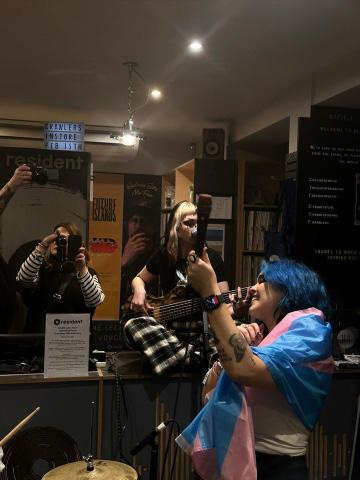
were the beneficiaries of TikTok’s recent exceeding influence over the music scene, with their breakout hit ‘Come Over (Again)’ going viral after releasing their debut self-titled EP. On reflection of their blow-up, Crawlers knew they had something special with this hit.
Amy: I think we knew, like when we recorded it, we knew [...] it was really special and we always had the idea that this would change things for us. Because it was completely new songwriting and, yeah, it was just really exciting. But I don’t think we thought it would do what it ended up doing.
Holly: It was a very emotive song at that point. We had always been a very political band, and this was the first song of self-reflection and about a lot of hardship. [...] It was really nice and cathartic to get it out there.
With their song taking over the internet, Crawlers developed a remarkable relationship with their fanbase, mirroring the dedication of My Chemical Romance and, more recently, Mother Mother, whom Crawlers are supporting on their UK-wide tour. They go the extra mile for their fans, holding listening parties and special events where the ‘Creepy Crawlers’ can meet and even befriend their idols.
Concerning The Mess We Seem To Make, Crawlers hosted a listening party (or as they called it, ‘The Wake’) for their single ‘Would You Come to My Funeral’, an upbeat and driven track with emo influence that provides an anthemic punch to round off the first half of the album. Their consistent interaction with their fans highlights the true reasons of why they make music with so much heart.
Holly: I was speaking to some fans and a lot of our fans have not even bought our album once. They brought it seven times, but not just because they
wanted all the bearings, but because they wanted to support us. Yesterday, our fan Meg [Crawlers Superfan and ‘Creepy Crawlers’ fan account admin] went “I’m paying your rent”. I went, “You actually kind of are”. We wouldn’t be able to do anything that we’re doing now without the constant support of our dedicated fans. We’ve done everything we can to implement a safe space for young, marginalised groups and being able to see fans be so unapologetically themselves is absolutely everything. It makes me so happy
We’ve done everything we can to implement a safe space for young, marginalised groups and being able to see fans be so unapologetically themselves is absolutely everything.
With the die-hard support of their fans, it’s no surprise Crawlers pulled out all the stops with this album. Leaning into themes of hardship and introspection, Crawlers expertly blended genres to curate a debut album unashamed of its vulnerability, embracing the complexities and difficulties of adolescence.
Holly: Overall, looking at The Mess We Seem To Make , it is that kind of looking at everything. We are self-aware that we fail and have problems [...] and the kind of conversation and dialogue around it, but the lack of [a] fix. It doesn’t get into that kind of hopeful end until the last songs on the album. It’s for the selfaware, chronically online generation, which is basically me exposing myself. My standout track on this album had to be ‘Golden Bridge’, a slower, more orchestral take on the themes mentioned above. It leans into the feelings of grief
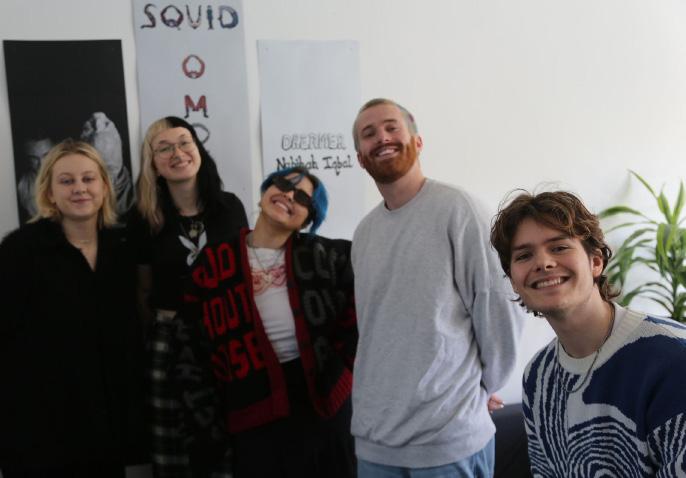
and loss, utilising a beautiful piano foundation courtesy of Neil Cowley (known for his collaborations with Adele) to carry the song forward.
Holly: With ‘Golden Bridge’, it was written very early in 2021, before we were a funded band. We hadn’t got that cult following just yet. We kind of had a few sole supporters but not enough to have that belief. My nephew had just been born. When Eli was born, I was suddenly like, you know what, I am very depressed and thinking the worst things ever, but there are things that make you want to keep going. And I was there for when he first smiled which is kind of what the chorus is about.
This is an extremely solid debut album for Crawlers. They balance the project very well, from ballad-like tear jerkers in the forms of ‘Golden Bridge’ and ‘Come Over (Again)’ to the anthemic and driven grunge hits like ‘Kiss Me’, ‘Hit It Again’, and ‘What I Know is What I Love’. The die-hards have plenty to feast on. Whilst it may not be for everyone, and sometimes they bite off more than they can chew, it affirms Crawlers as a band to keep an eye on in the modern British guitar music scene.
To watch the entire interview, be sure to follow the link to the official YouTube channel of The Badger
Sophie Martin Staff Writer
Universal Music Group has pulled all of their tracks from TikTok, meaning classics from the likes of Taylor Swift, Harry Styles and The Weeknd are no longer accessible. Since TikTok is a heavily music-based platform, this leaves questions over their future as we know it.
Universal released a statement on 30 January 2024 explaining why they have called time out on TikTok. They claimed that TikTok had failed to reach a deal that provides “appropriate compensation for our artists and songwriters, protecting human artists from the harmful effects of AI, and online safety for TikTok’s users.”
Universal claimed that TikTok attempted to “bully” them into a deal worth less than their previous agreement, which is not reflective of their exponential growth. They did this by selectively removing the music of certain developing and up-andcoming artists while keeping audiencedriving global stars on the platform. TikTok is a huge platform with over a billion users. It gains most of its traction through trending music and accompanying dances. It’s common knowledge that Taylor Swift is one of the most famous musicians in the world, who has a major influence on her fans. The removal of her music may lead to a decrease in Swifties, along with other users who may leave the app in solidarity with their favourite artists, who Universal
claims are not receiving “appropriate compensation”.
The removal of her music may lead to a decrease in Swifties, along with other users who may leave the app in solidarity with their favourite artists.
TikTok is also an important platform for up-and-coming artists. Many artists have blown up on TikTok overnight. Lots of recognisable artists are said to ‘owe their career’ to TikTok. Doja Cat was already well known for some songs that hit the charts, but it was her song ‘Say So’ going viral on TikTok that led her to the top of the charts
and to becoming one of the biggest names in the music industry. A decline in users of the app, because of the attraction of wellknown music being removed, could lead to new musicians feeling unmotivated to start posting on TikTok – as the same level of fame and attention will no longer be as accessible.
It seems as though TikTok has tried to build a music-based business, without paying fair compensation. Universal’s stand against this is likely to lead to a decline in its success – with new and existing music reaching much smaller audiences as attraction to the app slowly fades.
how different is it to your first year of living in university accommodation?
Calling all reality TV fiends and superfans, Celebrity Big Brother is back – and hopefully here to stay!
After a dramatic breakdown of the nation’s favourite reality TV series back in 2018, many (including myself) waited patiently for an epic revival, and the wait is finally over.
Big Brother started as a social experiment back in 2000, its premise to observe human interaction in new environments. If you’ve been living under a rock for the last 20-odd years or so, Big Brother, at its core, is a bunch of strangers (in the case of this article, celebrity strangers) thrown into a camera-rigged house together. They’re under 24/7 surveillance and given tasks to complete in the hopes of earning a budget for their weekly food shop, as well as bonus perks like parties or treats. Their only contact with the outside world is the crowd booing or cheering on eviction nights as voted by the public.
The show might sound like a nightmare – but, minus the constant surveillance,
Random strangers in a new environment, check. Doing tasks (let’s call them lectures and seminars) in exchange for a club and partying night out, check. Struggling with a measly shopping budget for your weekly food shop, check. Swap in the crowd booing for the random screams you hear outside your flat at 4 am, and you’re basically a Big Brother contestant.
The announcement of Big Brother’s return back in 2022 left shockwaves

across the nation, with #BBUK trending within minutes on Twitter. The revival civilian season which aired in autumn 2023 surpassed many expectations and brought in thousands of new fans. Arguably, Celebrity Big Brother’s return has come at a crucial time. It’s undeniable that the UK’s reality TV scene has been bleak these last 5 years. Gone are the days of unscripted reality TV; we’re forced to choose between wooden Love Island producer-influenced scripts or over-exhausted formats such as I’m A Celebrity Get Me Out of Here. But the reality TV gods have finally delivered… and CBBUK is back on our screens!
Celebrity Big Brother is currently airing on ITV1 each night, and so far features an interesting cast, with reality TV legends such as Sharon Osbourne and Louis Walsh now in the house. Everything indicates it’ll be an interesting series worth tuning in for.
The standards are high for the star-studded cast, as many of you may remember the iconic season with Gemma Collins and her famous one-liners (“I’m claustrophobic Darren!”) which sparked dozens of memes.
However, Big Brother has always prided itself on acknowledging and representing
the UK’s diverse population and walks of life. In the recent civilian Big Brother, the series featured a transgender woman and a disabled man – something Love Island’s producers could only dream of considering. Someone on Twitter referred to the civilian cast of Big Brother as looking “like your average bus in London, I love it!” Seeing a representative slice of society on our TV’s every night is what makes the show so authentic and relatable.
Is this what Love Island is missing? In chasing aesthetic perfection, has the villadwelling show killed itself off? It’s clear everyone is sick of the façades; Love Island: All Stars (2024) was the show’s lowestwatched season since Love Island’s humble beginnings began back in 2015. Essentially the same premise of Celebrity Big Brother, where former contestants return to find love a second time, it was surprising to see the viewing figures so low. It will be interesting to see how Celebrity Big Brother compares. After all, you can’t spell reality TV without real – and it’s obvious the people of Britain want it back on our screens.

Average. If I could describe Netflix’s Avatar: The Last Airbender (ATLA) live-action in one word, it would be average. After six years of waiting, ATLA’s live-action has finally come out and all I can say is that it’s… deeply disappointing. As a general rule of thumb, I am incredibly sceptical of live-action remakes, particularly those with fantastical elements to it (such as magic). So, when I heard about a live-action ATLA, I wasn’t exactly ecstatic, especially after the debacle that was the Fate: The Winx Saga series. Furthermore, when I learnt that the two directors of the original animated show, Michael DiMartino and Bryan Konietzko, had left the production of the show due to creative differences with the studio, any lingering hope died and disappeared.
From episode one, you’re thrown straight into the drama (as I would later come to find out, most episodes start this way). There’s a member of the Earth Nation running with a scroll being chased by Fire Nation soldiers, who are throwing fire at him. This is where viewers first get to see the use of powers in the show, and I’ll admit the CGI wasn’t awful, although it should be noted that whenever there is earth
bending, there are weird camera angles in use. However, this level of CGI didn’t last for long as only a couple minutes later there is a scene where that Earth Nation member is being burnt alive and the CGI is akin to the effects that you would use on Photobooth as a child all those years ago. Furthermore, at certain points the CGI makes the show look almost animated or really badly edited.
There is also an issue with pacing. At the beginning, I liked how they showed Katara’s water bending evolution. However, from episode five onwards, the evolution of Katara’s powers is incredibly rushed. She goes from barely being able to do a water whip in episode three, to creating an entirely new move in episode five, and then suddenly becoming a master in episode eight. Whilst I understand that it is hard to properly show the evolution of a person’s skill in eight episodes, I’m certain that Netflix could have dedicated more time to this. There is also an issue with time sensitivity. For example, in the episode with Ko, it is unbelievable that the hostages were not eaten by the time Aang came to save them.
Another thing I don’t like in the liveaction are the fight scenes. I love fight scenes, I’m obsessed with them, so I feel qualified enough to pass proper judgement on them. A lot of the fight scenes in this show were rubbish, some were limited due to CGI. But others were rubbish because
they followed the formula of exceptionally weak goons. In almost every episode that Aang and his friends fight Fire Nation soldiers, they are defeated comically easily. I will admit there are some fights that are above sub-par, for example whenever Zuko fights. His fights are genuinely very entertaining and the choreography is generally quite good (a standout being his fight with Aang in the fabrics). But, that kind of fighting quality is so far and in between that it is very likely to be drowned out by all the bad.
However, for all its faults, there were some good things about the show, namely some of its casting choices. The casting of Zuko (Dallas James Liu) was quite simply immaculate. Dallas perfectly portrayed the desperation, obsession for the Avatar and constant need for fatherly approval that makes up Zuko’s character. Although this might be a controversial opinion as many fans wanted the actor who played Jet (Sebastian Amoruso) to play Zuko just based on his looks. However, I’m personally of the opinion that both actors were perfectly cast for their roles. Another character who, in my opinion, was perfectly cast was Sokka (Ian Ousley). Ian flawlessly portrayed Sokka’s cockiness, insecurities and love for girls. More than that he perfectly mirrored the cadence and demeanour of his animated counterpart. Lastly, the casting of Uncle Iroh (Paul Sun-Hyung Lee) was very good. He characterised his animated
version very well but, I will say his accent in the show is very weird and was annoying to hear.
As harsh as it sounds, I recommend this show to those who want to go to sleep, have some background noise whilst they do their homework, or are incredibly bored. Head to thebadgeronline.com for the full article!

Isabella Poderico Arts Editor
For many tweens like myself in the early 2010s, watching a teenage dystopian drama was the pinnacle of my week. I was an enormous fan of various book-tofilm franchises, from Mortal Instruments to Ready Player One. I can still remember the bustling excitement of watching The Maze Runner, Divergent, and The Hunger Games in the cinema for the first time. Watching these dystopias acted as a form of escapism for me; it was a journey to another world, one with problems more extreme, more dangerous, and most importantly, more exciting. We have all imagined what we would have done if we were drawn to take part in the ‘Triwizard Tournament’, or perhaps if we were ‘reaped into The Hunger Games’, with these thrilling adventures becoming a staple discussion in my tweenage friendship groups. But what happened to this oh-soloved genre of film adaptations? What has led to their downfall, and ultimately their disappearance? With the success of The Hunger Games: A Ballad of Songbirds and Snakes, will we see this genre triumph in our cinemas once again?
Perhaps dystopian films are merely there to provide shortlived thrills that only young people can enjoy before their frontal lobe fully forms.
The dystopian genre has been around, debatably well before the early 2010s with
films and books like Blade Runner and A Clockwork Orange paving the way for these creative, and captivating science fiction futures. However, I am focusing on films targeted specifically at teenagers and young adults, the films that we grew up on. In my opinion, the real founding father of the teenage dystopian genre is the modern-day classic that is Games time fan of this series, and I wholeheartedly believe that The Hunger Games and is revolutionary. It dives into political issues, such as the horrors of an extreme capitalist future, teaching children of the brutality that the 1% in power oppress the 99% with. Other early classics include Runner all of which were staples in my dystopian movie marathon. At the height of the dystopian craze, these films generated jawdropping profits for studios, due to accumulating die-hard fan bases whose loyalty knew no bounds… until
A terrible sequel has proven capable of capsizing an entire franchise, and in the case of Allegiant Part 1 it not get a part 2, but in my opinion its ice-cold plunge

at the box office led to the demise of the entire teenage dystopian genre as we know it. The issue with that film wasn’t just due to fans losing interest in the relatively basic, dull franchise, but the fact it was a truly awful film with no substance; it was poorly written, made, and advertised. Other films put out to temporarily re-heat the now tarnished name Chaos , and I hate The Darkest Minds, did a poor job at reviving this now disintegrating genre. Studios barely attempted to reignite the craze, consequently failing. Fans of the genre grew up, actors lost interest in the already halfstarted franchises, and money was lost, due to quickly adapting books into poorly written movies. The dystopia was disappearing, decaying before our very eyes. No new films were reinventing the genre, there was no evolution, and plotlines between entirely different franchises began to blend due to overused
tropes like the love triangle. With this being said, could we be looking at the slow re-emergence of the dystopian genre? The overwhelming success of The Hunger Games: The Ballad of Songbirds and Snakes, which boomed at the box office, along with a Percy Jackson re-make in the form of a series, may be a convincing enough argument for studios to attempt to fuel the teenage dystopian genre. Perhaps dystopian films are merely there to provide short-lived thrills that only young people can enjoy before their frontal lobe fully forms. Regardless, I wholeheartedly support a new wave of dystopian films to (hopefully) re-emerge. But do we even need dystopias? Debatably we are living in one. The state of the world has continued rotting; we are living in a war-torn, genocidal, capitalist hellscape. People watch movies for escapism, and dystopias are starting to reflect a world a little too close to home. Maybe that makes audiences uncomfortable? Explicitly highlighting the issues of our own world, which more often than not are at the hands of the exponentially rich, or scarily fastdeveloping AI technology, mirroring our own world suspiciously closely. Critiques of our own society portrayed through art forms like film are much needed, allowing for audiences to question societal issues, and actively engage in political discussion.
Head to thebadgeronline.com for the full article!
Atreyo Palit Staff Writer
If you were a 90s/2000s kid who enjoyed watching television when growing up, one of the most exciting moments to look forward to would be the announcement of “New episodes start airing (insert date and time)!” Between re-runs of older seasons and repeat broadcasts of shows that had finished airing, there would come a time of a few months when your favourite show’s latest season would air a new episode every week. In excitement, you’d come back from school in a hurry or wake up early on Sundays just to watch the newest episode when it aired for the first time. Back then, the school’s timetable and your TV channel’s schedule were all the routines you had to keep track of. But with more commitments appearing with time, there came a time when you decided to be done with scheduled TV. And just then, Netflix showed up! Now, you could log on and watch whichever episode of whichever show whenever you wanted. Yours was the only schedule to keep track of. And the best part? You could fill in larger chunks of free time by watching multiple episodes in
one go!
With the blissful relief that streaming brought, a lot of us were able to get back to being invested in TV again. Who doesn’t know the excitement of waiting an entire year for the release of the new season of their favourite Netflix show, which they will binge over the weekend to follow? There’s enough data to demonstrate that Netflix has had more subscriptions than any cable network ever did, and why would it not? It not only allows for binge-watching, but it comes with no schedule, and it houses so many different shows at the same time! But of course, corporate greed knows no bounds. As if people aren’t invested enough already, Netflix and its contemporaries now want us to watch seasons in parts. Sure, being able to binge-watch entire seasons at once is a welcome break from the weekly airing, but both those approaches come with a sense of structure – you either show up once every week for an episode, or you seal off a large block of time from a day or two and watch every episode at once. But, what’s up with the two-part seasons? 13 Reasons Why aired 13 episodes at once for four consecutive years, and more recently, we will get just four episodes from Bridgerton after a two-
year wait. No wait – short or long – justifies getting just four hours of content of a continuing story! The strategy of releasing seasons in parts is an insult to viewers’ investment in a show. People’s interests aren’t playthings to experiment with as studio executives wish!
There would be no entertainment industry without the investment of people looking to be entertained.
The popularity of streaming creates trends everywhere, the biggest proof of which is that there are so many major streaming platforms now, with HBO Max, Paramount+, Apple TV, Disney+, Amazon Prime Video, and Netflix, among the more popular ones. So, while the half-season may have felt like a fun release every few months during the pandemic when we were all locked in and looking for things to watch, it sets a horrible precedent. Anime has almost always aired on a weekly basis and has barely ever been produced for straight-to-streaming purposes, with the notable exception of Netflix’s Demon
Slayer. So, the fact that Attack on Titan aired its final season in two parts is proof that this is becoming a trend now. It can be attributed to the widespread popularity of the show in the US where the trend first showed up.
As much as there wouldn’t be shows without the hard work of crews who bring these stories to life, there would be no entertainment industry without the investment of people looking to be entertained. Studios should stop underestimating their audiences. Attention spans do vary across generations, but getting four hours of content after waiting two years is frustrating! If we could care about a show that aired twenty minutes every week for six months, before disappearing for another six, long enough to watch six or seven seasons of it, we can definitely wait long enough for you to prepare one season’s worth of content. Disney+ has brought back the weekly model for its MCU shows, and even that is more fun (eight episodes only require a couple of months to air) than watching seasons in parts. Stop toying with our investments in your stories, studios!
Sophie Martin-Patrick Staff Writer
This month I had the opportunity to speak to Ray Young, the creative director of OUT. Ray told me how the performance ‘began as an experiment, and we didn’t expect that it would take off in the way it did, but when it did it was a happy accident.” After hearing Young speak thoughtfully and insightfully about the project, it is easy to see why it has achieved success. In its creation, Young expressed how “The work was not trying to make a social contribution or impact, but as interest in the work grew we realized that it is something that was of interest to other people.”
I enjoyed speaking with Young about the different themes in the piece and how they still hold relevance and impact today. One of the central themes explored in the performance is homophobia and transphobia. Despite being created in 2016, Young told me how “the work is still relevant today.” They spoke about how the current political climate has been a challenge: “We
have to think about how to create this work safely for the performers involved when we have a government that is very hostile and doing things that feel deliberate to prevent LGBTQ+ communities access to healthcare and make choices about their own gender expression. We know it is a sensitive time to do the work, but we want to do the work because it is important.”
“
We know it is a sensitive time to do the work, but we want to do the work because it is important.
The development of this project was based heavily on the creator’s own experiences since “being part of those identities is the way the work is built.”
Using their own experiences has been a central theme across Young’s work to create conversations: “I’m often making work from the viewpoint of how I see the world and then having conversations with people who experience the world in the same way or different from me and using
those conversations to understand why I want to make this work.”
Young shared how they hoped OUT would affect the audience watching the performance, “sometimes people feel like it opens a door to them and the things they were feeling and when they see themselves in the work it is powerful, but it is also powerful in the other way when people don’t see themselves in the work and the way it makes them feel because they are often people who are often always seen and may feel affronted when they are not. They are both powerful and useful.”
The autobiographical element is also evolving. Young is now stepping back from performing in the work as it “becomes generational” with new performers, stating “Now that Bambi and Azara are performing in the work I think it will change slightly because of their own experiences”.
I asked Young about the challenges that come with using personal experiences and how they navigated authenticity and vulnerability when creating such personal work. “When you come from a marginalized community there is an appetite for work
that feels like it is re-traumatising, so there is a safety and care that needs to sit around the work,” Ray told me, “I only ever perform what I feel like I am willing to…If people do not feel represented in the work they may feel obliged to speak unkindly about the work, so that’s something you need to be aware of and protect yourself from”.
When you come from a marginalized community there is an appetite for work that feels like it is re-traumatising, so there is a safety and care that needs to sit around the work.
The vulnerability and bravery in creating such a personal piece of work is what makes OUT so powerful at creating conversation around its themes of race, gender, colonialism and political discourse. OUT will be performed on campus at ACCA on 19 April if you wish to see it for yourself.
Ceylan Akturk Staff Writer
Ah, theatre kids. You might have heard about or known theatre kids before! Maybe you even were one of them once? I guess you can picture a group of teenagers who think they are the main characters and are always ready to leave class to break into a spontaneous dance routine. But where have they gone? As a former theatre kid myself, let me take you on an exploration into the world of the stereotypical theatre kids.
So, what exactly is a theatre kid? I want to start by speaking of this popular meme that says, “We’re … Of course we …” I recently saw a theatre kids’ version on TikTok. The video consisted of a bunch of high school theatre kids saying, “We’re theatre kids. Of course, we only get four hours of sleep a day; of course, we are going to sing in the hallway, and of course, we have dyed hair.” It sounds pretty much like the stereotypical theatre kid, right?
Then, let’s talk about the stereotypes. Theatre kids are usually labelled as having attention-seeking, flamboyant personalities that thrive on drama both on and off stage. I can definitely say that some of us were emotionally neglected, validation-seeking kids, undoubtedly contributing to the already existing stereotypes. As a middle child, I was constantly seeking validation, and theatre was a vehicle that I used to receive praise
and approval; so I could easily relate to the stereotypes.
There is also this stereotype that theatre kids have an in-depth knowledge of musicals, leading us to the origin of the stereotype that became mainstream with
theatrical genius to Rachel’s stunning performances. Everybody aspired to be a member of the Glee Club - dominating tournaments and rising to fame. In a way, Glee gave a voice to loud and proud theatre kids. The show spoke to theatre kids’

theatre kid persona, yet revealing the complex layers and nature of them.
The stereotypes aren’t entirely off base, though. We theatre kids really do stick together like glue! Those little groups were super diverse too - every kind of person you can think of was part of the crew. I know people believe theatre kids were all flashy extroverts, but some of us were introverts who used theatre to come out of our shells. Like me! Yep, I was a very introverted kid who did theatre to make friends and get help with self-expression. It was the best decision ever. Theatre kids just got each other, even with our different personalities.
And let me tell you, being a theatre kid required some serious dedication. I’m talking about spending hours after school rehearsing; learning lines on weekends; sacrificing pretty much all your free time. For us introverts, it was even harder to put ourselves out there! But we persevered because we loved it so much. There was a great deal of emotion, as well as off-stage drama…
Teenagers nowadays have access to new platforms for their performative creativity, such as YouTube and TikTok. However, theatre is still one of my favourite memories from school, even if we’ve grown up and moved on - nothing truly captures the magical sense of being the centre of attention. After all, once a Gleek, always a Gleek!
Image: Fox

Bella Rosanes Staff Writer
G“It was a great combination of talents with great direction”
oing into the show, I didn’t know what to expect. It has been a while since I’ve seen a stage production, after all. But upon the very first notes sung, pleasantly surprised would be an understatement. The opening was not only gripping and wellreceived but it also introduced the amazing performers and their strengths perfectly. Each character, from the main cast to The Ancestors, played their parts to their best renditions, and created a musical that was haunting, hilarious, and heart-warming.
From the get-go, the gripping stance and gravitas of Gomez was perfectly captured and portrayed by Sam Ellyatt. His charisma brought the audience great laughs and awe. I particularly enjoyed his solo number ‘Trapped’ as his vocals encapsulated the audience through a song of his troubles as a good father and a good husband – a performance to be remembered, indeed.
Another remarkable performance was that of Pandora Seymour as Morticia Addams. Seymour’s chemistry with Ellyatt (Gomez) reflected the beautifully dark romance that Morticia and Gomez are known to share. Capturing a character that complex, from the way she walks, to the way her eyes dart around the room, is a sight to behold. This is with the addition of Seymour’s
gripping vocals that – despite obvious audio technicalities – perfectly projected through the whole room and never fell flat once.
Of course, the Addams family wouldn’t be the Addams family without their loyalty and affections. A chemistry captured by the heartwarming performances of: Scarlett Smith as Wednesday, Eleanor Evans as Pugsley, Matt Marshall as Uncle Fester, Lauryn Hill as Grandma Addams, and Morgan Owen as Lurch. Altogether, they created the perfect harmony of love and horror known to be the Addams family. I remember noting how fun it must have been to play Lurch as despite his very few lines, Owen made a compelling character that the audience loved from start to finish.
When I spoke to another audience member, they took note of how The Ancestors were more than just twodimensional characters. Their performers created stories, and their reactions to scenes made for a cohesive performance that never failed to track humour and drama. They also noticed that the costumes perfectly captured each character and their arcs throughout the entire set.
Overall, the play was a golden success, from start to finish. A magnificent production made possible by the many talents involved. From the amazing direction of Charles Eccles to the band, to the cast, and to all that made it possible.

“Some people are born to play certain characters, and the guy who played Gomez was undoubtedly one of those!”
Zeeshan Tirmizi Staff Writer
This was my first time watching any The Addams Family adaptations, so I didn’t know what to expect before entering the ACCA building. I felt flabbergasted after watching the incredible musical adaptation by SMUTS. The show was a full house, and it was evident from the audience that the show would be beyond my expectations.
Sam and Pandora brought the stage to life by portraying Gomez and Morticia. Gomez turned out to be a bold and lively character from the beginning to the end. In contrast, Morticia’s character dominates the stage as the key decisionmaker in the show. Whilst Gomez and Morticia come out as earnest characters, Pugsley and Grandma balance the family equation perfectly with their quirkiness and humour. It becomes evident in the first act that they’re the soul of the Addams family. On the other hand, Lana and Etienne beautifully portrayed the contrasting nature of the Beineke family with their characters, Mal and Alice.
Between the comedic tension between the Addams’ and Beineke, the theme of romance was brought to life through the romantic and humorous scenes between Lucas and Wednesday,
portrayed by Elliot and Scarlet (Their kissing scene was romantic enough to make the audience blush!) Whilst the musical had the space for romance between lead characters, the ancestors also had their own stories running parallel: Gomez and Morticia kept the audience hooked with their strong personalities, and the ancestors made sure to make the audience laugh with their timely placed comic scenes!
It was no surprise that everyone was in awe of Libby’s production and Charlie’s direction. However, it is also important to note the role played by the musical artists, who were some of the crucial characters behind the success of this musical, along with the backstage crew who continuously carried and transferred big objects between the scenes!
Overall, SMUTS’ The Addams Family is one of the best musicals I have ever seen, with its powerful performances, jaw-dropping music and phenomenal efforts in the production of the show! I am excited to see what the SMUTS brings for Sussex students in the future - I will be among the first ones to buy the tickets!
Lydia Bowe Sealey Staff Writer
The anxious chatter as the crowd fills the room, the sense of trepidation as the audience takes their seats and the silence that descends as the curtain rises. The theatre has always provided a constant source of entertainment; whether that be to evoke sadness, joy, suspense or even laughter.
As the Easter break approaches, Brighton’s theatrical spaces are teaming with productions and showcases. Whether you yearn for a Shakespearean Classic (see A Midsummer Night’s Dream at Theatre Royal Brighton), or a raunchy comedy at Komedia, there are a multitude of performances that you, your family and friends can see and experience.
Here at The Badger, we have assembled a timetable packed with a variety of showcases from across the theatrical spectrum that will appease even the toughest theatre critic! See below for all dates, ticket prices and locations.
Theatre Royal Brighton
Cluedo 2: The Next Chapter
19 – 23 March, 2:30 pm and 7:30 pm
Tickets from £13
The Secret Life of Fairies
4 (1 pm, 2:30 pm and 4 pm) – 5 (11:30 am, 1 pm and 2:30 pm) April
Tickets from £12.50
Brighton Dome
Dorothy Stringer Dance Show 2024 23 March, 7 pm
Tickets from £10.50
A Midsummer Night’s Dream
29 (2 pm, 5:30 pm) – 30 March (2 pm)
Tickets from £6.25
Brighton Philharmonic Orchestra
2023/24: Sea Songs
7 April
Tickets from £6.50
Under 14s must be accompanied by an adult
Tommy Tiernan: tommedian 11 – 12 April, 8 pm
Tickets from £29.80
Recommended for ages 15+
Ashley Gavin 13 April, 8 pm
Tickets from £24.50
Recommended for ages 14+
Komedia
Phil Green: Four Weddings and a Breakdown 27 March, 8 pm
Tickets from £10
Recommended ages 16+
Komedia Comedy Club
29 March, 8 pm
Tickets from £15
Strictly ages 18+
Teen Spirit – 90s Rock Night
30 March, 11 pm
Tickets from £5
Strictly ages 18+
Beavertits Cabaret and Burlesque
31 March, 7:30 pm
Tickets from £15
Strictly ages 18+
Attenborough Centre for the Creative Arts
Clark (Plus Support: Johanna Bramli) 21 March, 8 pm
Tickets from £20
Recommended for ages 14+
Ray Young: Out 16 April, 8 pm
Tickets from £10
(see The Badger’s interview with Ray Young on page 26!)
Emma Critchley: Common Heritage 23 April, 7 pm
Free admission
Advanced booking is recommended
Psychologists categorise the human desire to seek further knowledge or eliminate uncertainty as epistemic curiosity, fuelling questions such as “Are we alone?”, and “Is there life in the universe?”two age-old questions asked by scientists, philosophers, and general man alike. While scientific evidence of life beyond Earth’s atmosphere remains elusive, popular culture has long fuelled our imagination with images of intellectually sophisticated green antagonists and sprawling alien civilisations. However, the scientific search for extraterrestrial life began not with grandiose visions of intergalactic societies, but with humble investigations into the microbial ecosystems in some of Earth’s most extreme environments.
In 1977, a pivotal finding was uncovered by a group of marine geologists led by Dr. R. Ballard: the unearthing of naturally formed structures protruding from the Pacific Ocean seabed. These structures, known as hydrothermal vents, were found to be erupting chemically rich hot water into the cold depths of the Galapagos Rift. Although initially deemed uninhabitable, subsequent biological surveys revealed
a thriving ecosystem teeming with over 800 (and still counting) species, defying preconceptions of what constitutes a habitable environment.
Two possibilities exist: Either we are alone in the Universe, or we are not. Both are equally terrifying.
Microorganisms were found to be converting the chemicals and minerals from the vents,such as carbon dioxide, into palatable organic compounds that larger organisms were consuming symbiotically. Life had seemingly adapted to overcome the harsh conditions of this environment - demonstrating a marine habitat in which its tenants were thriving. In an equal exchange, chemosynthesis processes supported minimal photosynthesis to combat the lack of sunlight, and microbes exchanged food production as currency for the protective shelter of their hosts.
So, how does this relate to finding life elsewhere in the universe? If life could adapt and flourish in such extreme conditions on Earth, the search for extraterrestrial life in our solar system should extend to environments previously
deemed inhospitable, potentially out of the perceived habitable zone. Dr. Ballard’s discoveries paved the way for the concept of extremophiles (organisms thriving in conditions once considered untenable), thereby facilitating the hypothesis that extraterrestrial life, in whatever cellular form, could be within our universe.
This theory has been investigated through the modelling of Enceladus. A 2017 study conducted at Stanford University, utilising data from the Cassini spacecraft, explored the potential habitability of Enceladus’ subsurface water ocean, driven by organic and inorganic carbona fundamental component of life. While searching for extraterrestrial life involves considering various environmental factors such as phosphorus abundance and atmospheric temperature, Enceladus stands out as a compelling candidate to initiate exploration.
Building upon the foundational insights uncovered by Dr. Ballard’s team and leveraging previous mission concepts such as the Large Ultraviolet Optical Infrared Surveyor (LUVOIR) and Habitable Exoplanet Observatory (HabEx), NASA is charting new frontiers through the Habitable Worlds Observatory (HWO), in search of evidence indicating the presence
of extraterrestrial life. The HWO sees advancements in identifying biosignatures (chemicals indicative of habitability in the atmosphere, such as oxygen and methane) and is uniquely tailored to detecting and characterising exoplanets, especially those with habitable qualities.
Supported by the endorsement of the National Academies’ Pathways to Discovery in Astronomy and Astrophysics in the 2020s, the development of the HWO marks one small (well, giant) leap for mankind in our pursuit to discover signs of life beyond Earth’s corner of the solar system and, in turn, find out if we are truly alone in the universe. With the Nancy Grace Roman Space Telescope (a forthcoming space mission from the HWO aimed at surveying vast expanses of the broader universe) set to launch by May 2027, NASA is laying the groundwork for its next flagship astrophysics mission.
Ending by aptly quoting science-fiction writer Arthur C. Clark, “Two possibilities exist: Either we are alone in the Universe, or we are not. Both are equally terrifying.” With the advances happening at the Habitable Worlds Observatory, we are closer to finding out either way.
Watch this space...

Rana el Kaliouby is an incredible woman in tech who has made significant contributions to artificial intelligence research. She is an Egyptian-American computer scientist who grew up in Egypt and studied at the American University in Cairo, where she completed her Bachelor’s and Master’s of Science.
She then travelled to Cambridge University, where she completed her PhD in Computer Science. Following this, she migrated to America as a research fellow, working with a team to develop the Autism & Communication Technology Initiative.
Seeking to impact the larger world, she co-founded Affectiva - a company specialising in ‘Emotive AI’, which is facial recognition software that considers cognitive states and human emotions. Her research has profoundly affected the commercialisation of AI, and the industry wouldn’t be the way it is today without her contributions.
Kimberly Bryant
Rosa Hernandez Staff Writer
Kimberly Bryant, showed a gift for maths and science from an early age.

Despite challenges of inclusion and limited opportunities in her learning years, she studied Electrical Engineering and Mathematics at the world-renowned Vanderbilt University and went on to work in the biotech and pharmaceutical industry.
Bryant’s reputation is testament to her unwavering dedication and success. Yet the highlight of her professional career is her creation of Black Girls Code in 2011 - a nonprofit organisation aimed at encouraging and supporting girls of colour in the world of technology and computer science with a special emphasis on entrepreneurship.
By fostering knowledge, creativity and leadership, the Black Girls Code has empowered the next generation of girls of colour in STEM across the US and South Africa. Bryant’s journey in tech inclusion has enriched the lives of many and paved the way for a more equitable future in the STEM industry.
Nzambi Matee
Megan Delaney Staff Writer

Hailed as a Young Champion of the Earth by the UN Environment Programme, Nzambi Matee has channelled her frustrations with the rising problem of plastic pollution into a solution: recycled plastic bricks.
It may sound small, but her idea of mixing recycled plastic with sand to create bricks seven times stronger than concrete has had monumental impacts.
In the city of Nairobi in Kenya, Matee has followed her personal motto to ‘act for nature’ and developed a company that turns 500 kg of plastic waste daily into high-quality and sustainable building materials.
Plastic is a major pollution issue, but her company has changed the narrative and utilised plastic waste rather than leaving it as just another global burden to be solved.
Hedy Lamarr
Mia Sawyer Staff Writer

Have you ever wondered where the basis of WiFi and Bluetooth systems originate? In honour of Women’s History Month, this article centres on Hedy Lamarr, an Austrian-American actress and inventor who pioneered the technology that would be the foundation for today’s WiFi and Bluetooth systems.
In 1940, Lamarr met George Antheil at a dinner party. They both shared the same inventive traits, and the two created an extraordinary communication system intending to guide torpedoes to their targets in war. The system involved the use of frequency hopping amongst radio waves, with transmitter and receiver hopping to new frequencies together.
Lamarr did not receive recognition for her invention until 1997 when she was awarded the Pioneer Award.
Ispy with my little eye… nothing. No ice over miles and miles of ocean.
Despite Antarctica being far away from those of us living in Sussex, climate change is an issue closer to home than you may think, with parts of Sussex’s coastline soon to become Atlantis, possibly completely submerged by 2050.
This is a real problem we could face if the Antarctic ice sheets continue to melt at fast rates, but yet exactly how much global sea levels would rise is still under rough estimation. Though Antarctica may have become the “poster child” of climate change, in reality, Antarctica is not well studied at all. Most of the landscape is uncharted territory, and exploring these blank spaces on the map is crucial to revealing important information on the topography of Antarctica’s underwater mountain ranges to predict how fast ice will melt. But why are scientists concerned about the underwater landscape of Antarctica? Take ice skating for example, if the ice is smooth, the ice skater would have no issue gliding across the ice at high speeds, but if the ice was rugged and spiky, it would surely slow the ice skater down. The same principle applies to floating ice sheets, where a mountainous underwater terrain creates more friction and as a result slows down ice flow. Similar to defrosting frozen meat under running water, increased
water flow results in faster melting rates. This is where drones come into play, not because scientists can sit back and relax in their offices and let the drones do all the work, but rather, ice penetrating drones play a crucial role in the study of these hidden giants, making the terrain of underwater Antarctica visible on screen. Such technology is not completely unheard of, in fact, the first large scale ice penetrating radar study was conducted in the 1960s. Satellite radar is used to measure the time taken for a radar pulse to travel from the satellite to the sea surface and back to the satellite. This can only infer the presence of tall protruding seamounts and very deep valleys based on the gravitational influence these topographical features have on the sea’s surface. Drones
have made it possible to map out areas vulnerable to fast ice flow in more detail and accuracy so that scientists can better predict exact numbers of sea level rise to prepare and inform us on how to combat climate change. And as Tom Jordan, a geophysicist specialising in airborne data collection says, “Polar science urgently needs extensive new high-resolution datasets to understand the ways the Antarctic ice sheet is changing, and how this will impact communities around the world”
Ice penetrating drones do not physically penetrate ice. Penetration happens when the drone fires pulses of radio waves through the ice, which bounces off the ocean floor. The drone retrieves these echos and records them as a data point,

using them to draw the shape of the terrain point by point. This new technology could potentially lead to massive groundbreaking discoveries in various fields, not only in climate science but also in studying glaciers and surveying deep sea marine ecosystems.
Polar science urgently needs new high-resolution datasets to understand the ways the Antarctic ice sheet is changing, and how this will impact communities around the world.
Currently, the British Antarctic Survey (BAS) test crew has conducted successful test flights over the Rothera Research Station in Antarctica with their newest model, the Windracers Ultra UAV, a 10 metre fixed wing drone, which can carry 100 kg worth of cameras or sensors for distances up to 1000 km along with a sophisticated autopilot system. The significant increases in flight time and geographical range compared to its predecessor, the Twin Otters, could potentially reduce CO2 emissions by 90%.
This new technology is definitely a game changer for climate science and kick starts a brand new discovery of the hidden natural wonders of Antarctica.
Jenny Choi Science and Tech Sub Editor
In a world brimming with technological marvels and advancements, it is easy to overlook the most essential element for life: water. On 22 March, the world pauses to reflect on the significance of this lifesustaining resource as we observe World Water Day. This annual event serves as a powerful reminder of the critical role that water plays in our lives, and the urgent need to address the global water crisis. The theme of World Water Day 2024, “Water for Peace”, underscores the transformative power of water as a catalyst for harmony, prosperity, and resilience.
This year’s theme emphasises the critical role that cooperation on water plays in fostering peace and stability on a global scale. One of the key messages for this year’s World Water Day highlights the dual nature of water. It can either create peace, or spark conflict. Scarce or polluted water sources can escalate tensions and exacerbate existing conflicts. However, by prioritising cooperation on water management, we can balance everyone’s needs and contribute to global stability. In many parts of the world, the simple act of turning on a tap and receiving clean, potable water is a luxury. According to the World Health Organization (WHO) and UNICEF, approximately 2.2 billion people

globally lack access to safely managed drinking water services. This staggering statistic underscores the magnitude of the water crisis and the urgent need for action. Developing countries bear the brunt of this crisis, grappling with a myriad of challenges ranging from inadequate infrastructure to pollution and climate change impacts. In regions like sub-Saharan Africa, access to clean water is not just a matter of convenience but a matter of survival. Millions are forced to rely on contaminated water sources, leading to a vicious cycle of poverty, illness, and inequality.
Amidst these challenges, there is a glimmer of hope. Across the African continent, various initiatives and projects are underway to tackle the issue of clean water access head-on. One notable example is the Improved Water Infrastructure Project in Uganda, Malawi, Rwanda, and Eritrea. It focuses on providing clean drinking water to small rural communities through the repair and drilling of boreholes. The project not only improves access to clean water but also contributes to the Sustainable Development Goals (SDG). The project directly contributes to SDG 6: Clean Water and Sanitation. Moreover, the reduction in the need for water purification through boiling alleviates pressure on local forests, thereby promoting SDG 13: Climate Action by reducing greenhouse gas emissions.
Furthermore, it contributes to improving health and wellbeing (SDG 3), promoting gender equality (SDG 5), and enhancing local infrastructure (SDG 9). Beyond its immediate goal of providing clean water, this initiative serves as a multi-faceted approach to sustainable development, addressing interconnected challenges and fostering resilience in communities.
In many parts of the world, the simple act of turning on a tap and receiving clean, potable water is a luxury.
Water holds the potential to lead us out of crisis. By fostering harmony and unity around the fair and sustainable use of water, we can bridge divides between communities and nations. From international conventions to local initiatives, cooperation on water can pave the way for a more equitable and peaceful world. As we commemorate World Water Day 2024, let us heed these messages and reaffirm our commitment to harnessing the power of water for peace. By working together, we will be able to build a future where access to clean water is not a source of contention, but a beacon of hope for generations to come.
Thomas Barlow Staff Writer
Roberto De Zerbi has done an excellent job since he was appointed the manager of Brighton and Hove Albion in September 2022, guiding The Seagulls to their highest top-flight finish in his first season in charge, after taking them to just their third ever FA Cup semi-final.
This season has been Brighton’s first ever in European competition. Following De Zerbis remarkable feat of guiding Albion to 6th place, this season has been remarkably entertaining for Albion faithful. With Brighton topping their UEFA Europa League group ahead of 2018 finalists Marseille and four-time Champions League winners Ajax, they have earned themselves a round of 16 draw against Italian giants AS Roma.
As of 27 February, Brighton are sat 7th in the Premier League and, as of writing sit ahead of the likes of Chelsea, Newcastle, and West Ham, with the Seagulls potentially heading towards another European adventure next season. This is testament to the job that Roberto De Zerbi has done in the last 18 months.
Due to the amazing job he’s been doing with Brighton, De Zerbi has inevitably been linked to many big jobs. He’s been tipped to become the next manager of FC Barcelona
or Liverpool amid the recent news that Xavi Hernandez and Jurgen Klopp will both be leaving their posts as manager at the end of this season. With regards to Liverpool, there’s a chance that departing Klopp may put in a good word for the Italian, as in October 2023 - ahead of Liverpool’s trip to the south coast - he described De Zerbi’s side as the “best coached team in the league.” There has also been gossip that De Zerbi could be Thomas Tuchel’s successor at Bundesliga winners FC Bayern Munich, after it was announced that Tuchel will be leaving the Bavarians at the end of this season.
Whether Roberto De Zerbi leaves Brighton at the end of the season is dependent on clubs paying his rumoured £15 million release clause, as Brighton owner Tony Bloom would not let him leave the club if that were not to be met. In the past, clubs have not been shy to meet the release clause for one of Brighton’s managers, with Chelsea paying a world record fee of £21.5 million to the seasiders for Graham Potter and his backroom team just 18 months ago. Yet, seeing as how things have turned out at Chelsea since the appointment of Potter, teams could be reflecting on this, and be a bit more hesitant to meet the release clause of a manager who hasn’t proven himself at one of the so-called ‘European Giants’.
In December, De Zerbi cooled speculation by stating that “Yes, we are speaking about the new contract, but at the moment we are only speaking, it’s not done yet.” It is likely that Roberto De Zerbi is happy to stay as the manager of Brighton and wait until a good managerial offer comes, which will benefit his career progression as one of the hottest young managers in world football currently. Brighton and Hove Albion CEO Paul Barber has said that the club are prepared if De Zerbi leaves and already have replacements in mind, with one of the candidates said to be another one of Europe’s hottest young coaches Ruben Amorim, who led Sporting Lisbon to their first league title in 19 years in 2021.

Ultimately, if Roberto De Zerbi is to leave the club at the end of the season, his move will have to make sense for Brighton, and be one from which his career will benefit. It will be an interesting few months, to see whether Roberto De Zerbi will lead Brighton into 2024/25 season, and with him in the past expressing his interest in a potential move back to Italy, and with Danielle De Rossi being appointed AS Roma Interim Manager until the end of the season, De Zerbi could potentially be managing Brighton’s UEFA Europa League round of 16 opponents next season. Hence, this tie could be a crucial one, not just for the club’s progression in Europe, but also in terms of whether Roberto De Zerbi will stay as Brighton and Hove Albion manager next season.
Football leagues aimed at students are common at the University of Sussex, yet none live up to the same standard as Bridge the Gap (BTG) Brighton. Whilst many leagues are marred by toxicity between players and cocky one-upmanship, BTG Brighton makes it a priority to separate itself as different. As someone who has attended three different football clubs at university, I am ardent that the Bridge the Gap football league is the best because of its unique commitment to ensuring you are friends with your team and - more importantly - with your opponents.
Bridge the Gap football league is the best because of its unique commitment to ensuring you are friends with your team and - more importantly - with your opponents.
Bridge the Gap’s mission is to create a player friendly environment, getting rid of the traditional tropes of bitter sportsmanship and bad energy common amongst football clubs. Its original mission was to find people to train as volunteers from local churches to run football sessions within their cities, offering open access football sessions, mentoring, glow-in-thedark matches and tournaments. Aimed at 18 to 30 year olds, it’s the perfect league to join at university. The next tournament, which is still open, will be in Bournemouth on 20 April. Notably, participation in the tournament doesn’t require you to have won consistently so far, meaning it’s open to those new to both BTG and league football.
BTG Brighton’s original and commonly overlooked aim, since its founding some 35 years ago, is to combat a startlingly high rate of suicide, the leading cause of death amongst people under 35 in the UK. Providing a weekly opportunity to socialise, exercise, and meet new people is crucial. In their words; “Aiming to build consistent and meaningful relationships
among those who might be struggling with life hardships, mental or physical wellbeing and or lacking,” all while “bridging the gap” between the 1.7% of people in England who attend church and those who don’t. While religious at heart and founded on the volunteering from churches across the UK, BTG does not require you to belong to any faith.
Bridge the Gap’s mission is to create a player friendly environment, getting rid of the traditional tropes of bitter sportsmanship and bad energy common amongst football clubs.
Led by Charlie Coats, the South-East and London Coordinator, you are drafted into random teams and allocated bibs to play a minimum of three games per session. Each session runs from 8-9 p.m. on a Friday night, however I suggest booking your ticket early in the week if you attend within a group to avoid missing out. It’s hard not to see BTG’s commitment when you join.
Charlie is an impeccably organised and charismatic leader of BTG Brighton (even giving my team a lift home out of kindness as we waited for the bus). His commitment alone was starkly noticeable upon my first session. I thoroughly advise any student with a slight interest in football to attend at least one Bridge the Gap session. It is in my opinion, the best football league in the local Brighton area as a student, especially with a group of friends. For those who are interested, BTG’s details are below.
https://bridgethegapfootball.org/
Friday Evening | 20:00 - 21:00
Brighton University’s 3G astro pitch, Village Way, Brighton, BN1 9QW
Over 18’s only
Jodie Fullerton Staff Writer
hough the thought of an hour of high intensity cardio may seem somewhat daunting, when it’s accompanied by upbeat and empowering songs with Latin influences, the idea becomes slightly more enticing. Zumba combines intense cardiovascular exercise with light-hearted, entertaining dance choreography, a rising phenomenon taking both Sussex University and the world by storm. The Sussex Zumba Society prides itself on creating a positive and welcoming safe space for all members, in which classes simultaneously aim to boost both your cardiovascular fitness and selfconfidence.
The routines practised within the weekly Zumba sessions require an immense amount of perseverance, as the hour-long classes target a variety of muscle groups, whilst also strengthening the heart and lungs. Attending the weekly classes has both great physical benefits and commendable mental benefits; improving participants self-confidence, encouraging individuals to make new friends, and providing the opportunity to have an hour of judgement free, stress-relieving fun.
Though much debate arises around whether Zumba can be classed as a sport, the senior
members of the Zumba society aim to ensure that no participant leaves without breaking a sweat. According to ‘Healthline’, you are able to burn between 300-900 calories during one hour of mid-to-highintensity Zumba – so whether it’s defined as a sport or not, attending the weekly sessions is a great way to achieve your fitness goals.
As one of the more affordable fitness classes available at The University of Sussex, with single sessions priced at £4 or £6 for two classes, Zumba is an excellent exercise program that is both intense and enjoyable. The sessions are led by
an externally hired Fitness Marshall who balances a professional environment whilst encompassing the sessions with laughter and fun. If running or athletics are not your thing, the Zumba society would be an excellent alternative form of exercise.
Despite their constant positive approach, the society has faced many setbacks and obstacles in the past few years. Issues such as the inability to sell tickets and the constant struggle to find unoccupied classrooms to book each week are just a few examples of the issues that the society have tackled in a professional and inspiring manner. The senior members of the society
display honourable dedication and passion for the fitness program through the way in which they handle these issues, continuing to provide two training sessions each week for the enjoyment of their members.
Tackling the stereotypes and assumptions that surround Zumba as a form of exercise, the Zumba Society aims to move away from the generalisation that Zumba is a fitness program reserved ‘just for women over 40’. President Ella commented, “The society welcomes participation from all members of the Sussex community; all genders and fitness levels, whether you have previously participated in Zumba or not”. Though the attendance of recent sessions has been predominantly female, the society aims to break these rigid assumptions, Ella stating that “we facilitate everyone! All we ask is that they have a passion for Zumba”.

The senior students of this society truly embody everything that Zumba stands for, and they are a part of the reason that the weekly sessions are so enjoyable. One first year member stated “they are the reason that I love to come to these sessions each week”.
‘Loud and proud about Zumba’, President Ella urges everyone to “Come to Zumba! You might surprise yourself and have a lot of fun”.
Hoithem Lhungdim Staff Writer
Marathon running brings people together from various walks of life (pun intended). From seasoned athletes to casual runners, marathons have gradually evolved into something both competitive and non-competitive. The Brighton Half Marathon is no exception.
Completing its 34th year in 2024, the Brighton Half Marathon is one of the first major half marathons in the running calendar and one of the most popular races in the UK. It was started by a small group of individuals in the early 1990s. The money raised from that very first event was used to fund The Sussex Beacon, a local charity which organises the race. Today, the Brighton Half Marathon is the biggest annual fundraising event for the charity, supporting a specialist HIV care centre in the city. More than 10,000 people were said to be participating
in the event this year. Some of the popular names include Barbie and Sex Education star Connor Swindells and Emmy award-winning filmmaker Chris Terrill.
For this year, the chosen start and finish of the race was Madeira Drive, which is close to the Steve Ovett statue in town. Participants ran along the seafront and past some of the city’s major landmarks, including the West Pier, Royal Pavilion and i360 tower.
“Over the past three decades, the race has grown in numbers and is now one of the largest running events in South East England.
Over the past three decades, the race has grown in numbers and is now one of the largest running events in South East England and a significant fundraising event for many charities and causes. This race was no
exception. For instance, Connor was running in memory of his mother who passed away due to bowel cancer twenty years ago and was raising awareness with Bowel Cancer UK. On the other hand, Chris was running for the Royal Navy and Royal Marines Charity, as well as raising money in memory of his late friend Bob Hawkins, a Royal Navy Commander.
Local newspaper The Argus wrote about James Power, a construction company worker who ran the Brighton Half Marathon to raise funds for the hospice charity which cared for both his partners, who had cancer. He lost his wife Natalie to stomach cancer, before losing his following partner Nicky to lung cancer. He has run the Brighton Half Marathon every year since 2020, after a promise he made to his late girlfriend. Coincidentally, Nicky was supposed to run the Brighton Half Marathon in 2019 with her best friend but was too ill and instead cheered her on from the sidelines.
Many race events, including the Brighton Half Marathon, are accommodating to people
with disabilities and have a separate category for wheelchair races. In this year’s race, Illias Zghoundi took first place in the men’s race with the women’s race won by Claudia Burrough.
“Thus, the event is a great representation of the spirit of sportsmanship, as we get to see people running together for different purposes and causes, in peace and harmony.
Thus, the event is a great representation of the spirit of sportsmanship, as we get to see people running together for different purposes and causes, in peace and harmony.

Across 3. _____ age: Historical period between the stone age and iron age (5)
4. Physics phenomena named by Newton (7)
8. Noisy neighbours building West Slope (7, 6)
9. Caroline _____: Departing Green Party MP for Brighton Pavillion (5)
12. Which Attenborough is the ACCA named after (7)
13. Month of Brighton Festival this year including free and student discount events (3)
14. City considered the birthplace of pizza (6)
By changing one letter at a time, can you get from one word to the other?


Top ladder word in the past tense
Music style of syncopated basslines, drumbeats and grooves
To give money, money saved for a purpose
Down
1. What brand of cafe moved into the Library this term (5)
2. Largest campus laundry company in the UK (7)
5. World’s largest desert (10)
6. The ____ Tour became the highest grossing concert tour ever last year (4)
7. Pathetic _______: storytelling technique where weather represents the mood/tone (7)
10. A group of badgers (4)
11. In which country is Easter Island (5)

Create as many words as possible with the letters in the wordwheel. There is one word using all of the letters. You can only use each letter once and every word must contain the letter in the centre of the wheel. Letters must be followed by a letter in a section next to it. WORD WHEEL


All puzzles created by Andrew Malarkey

